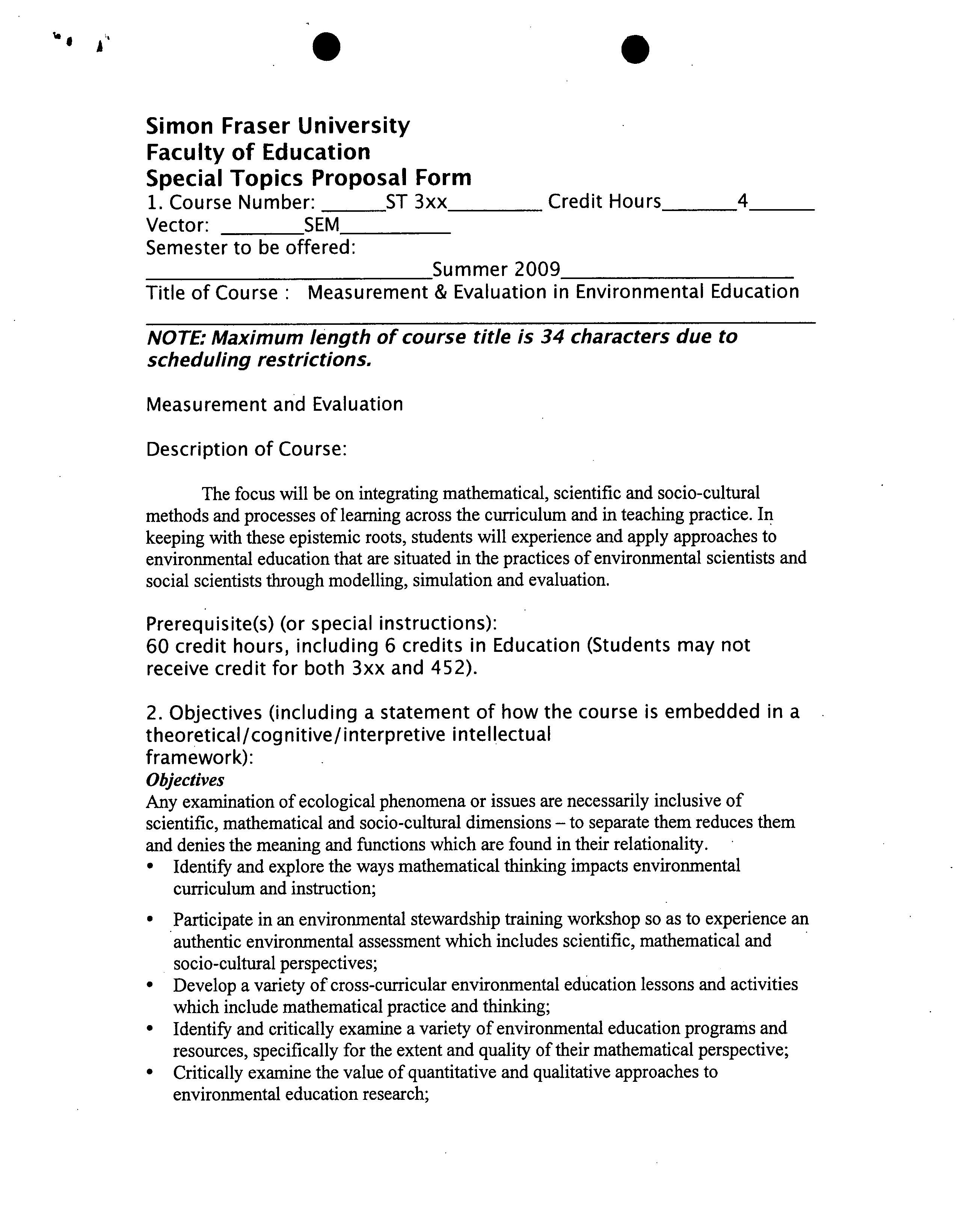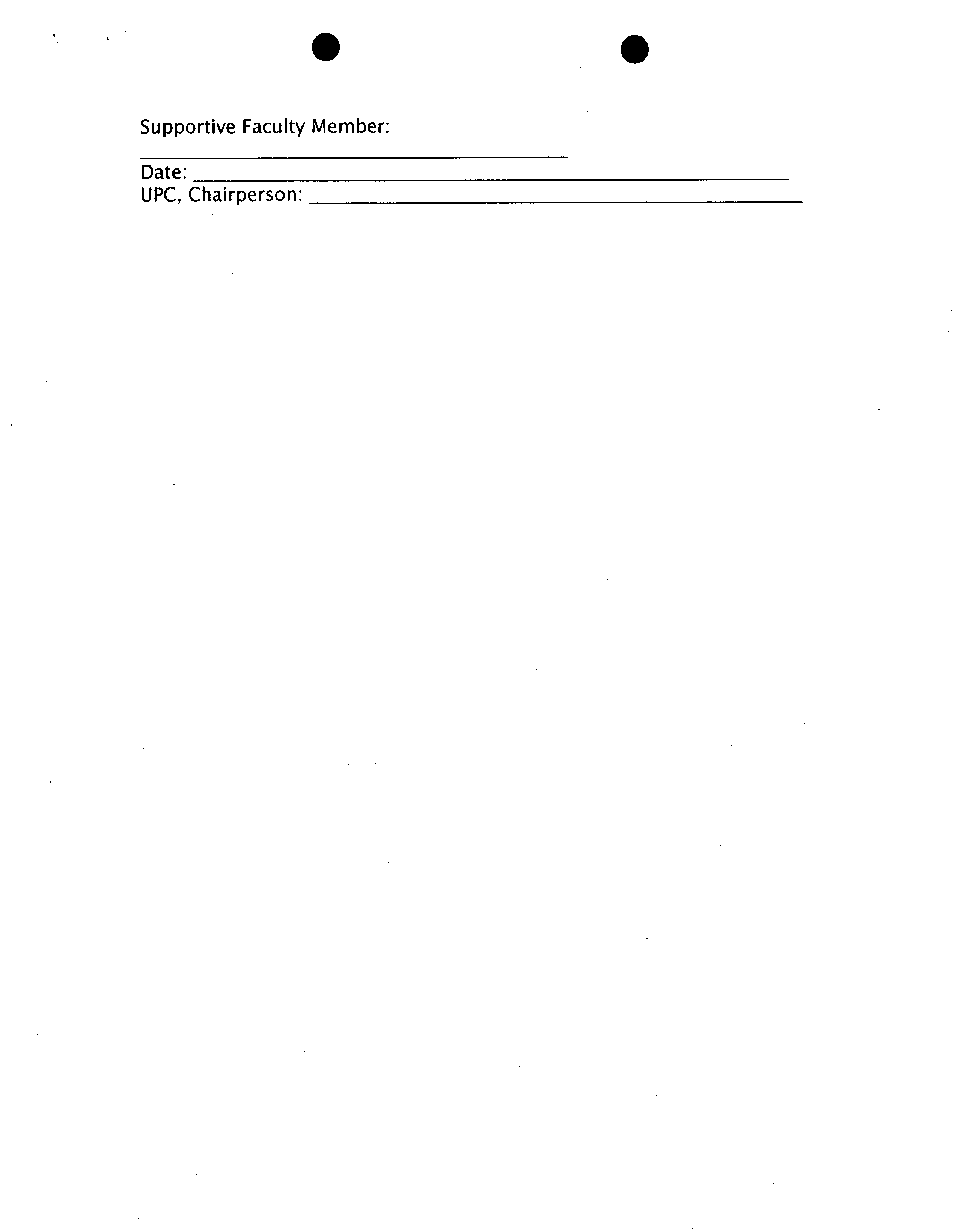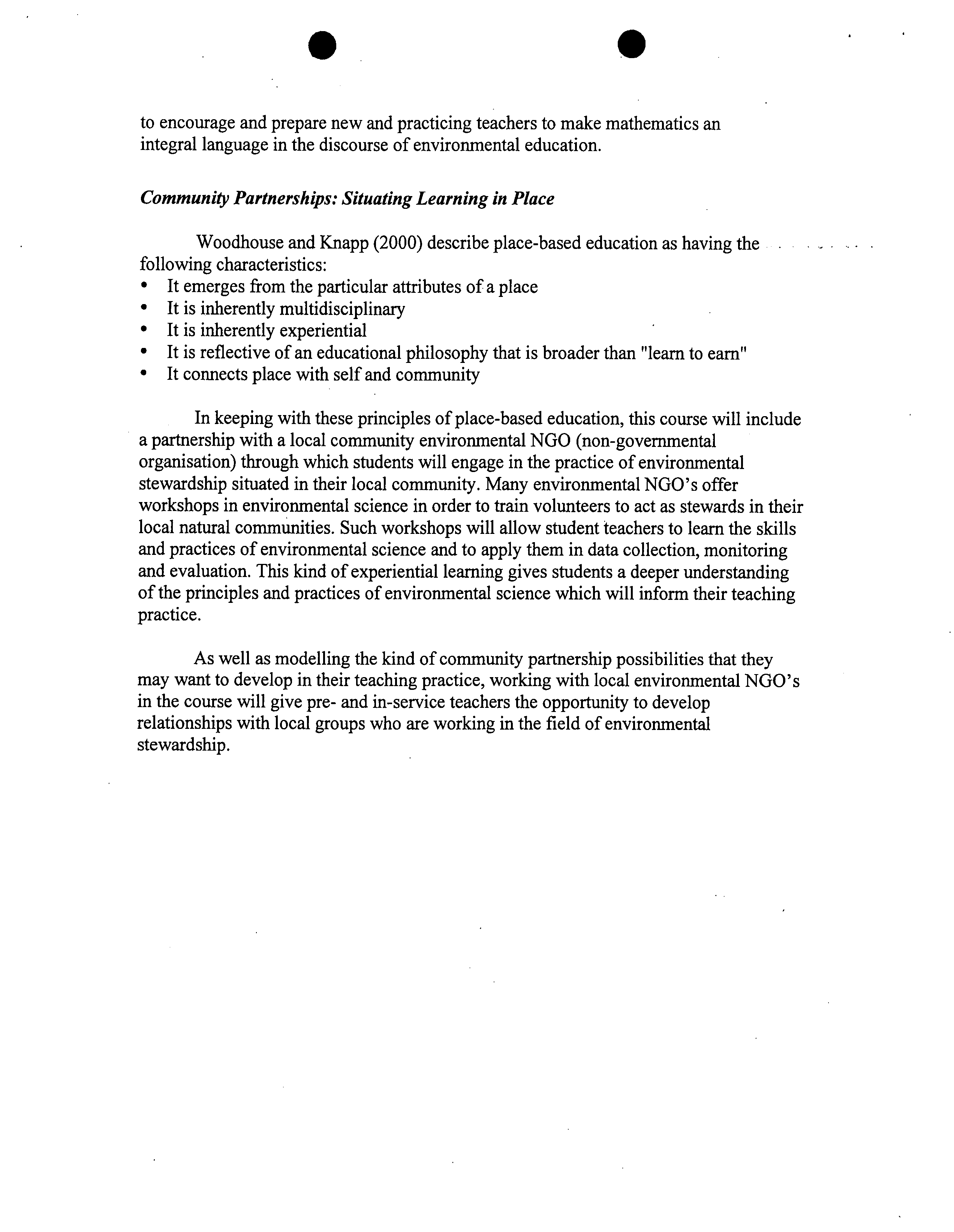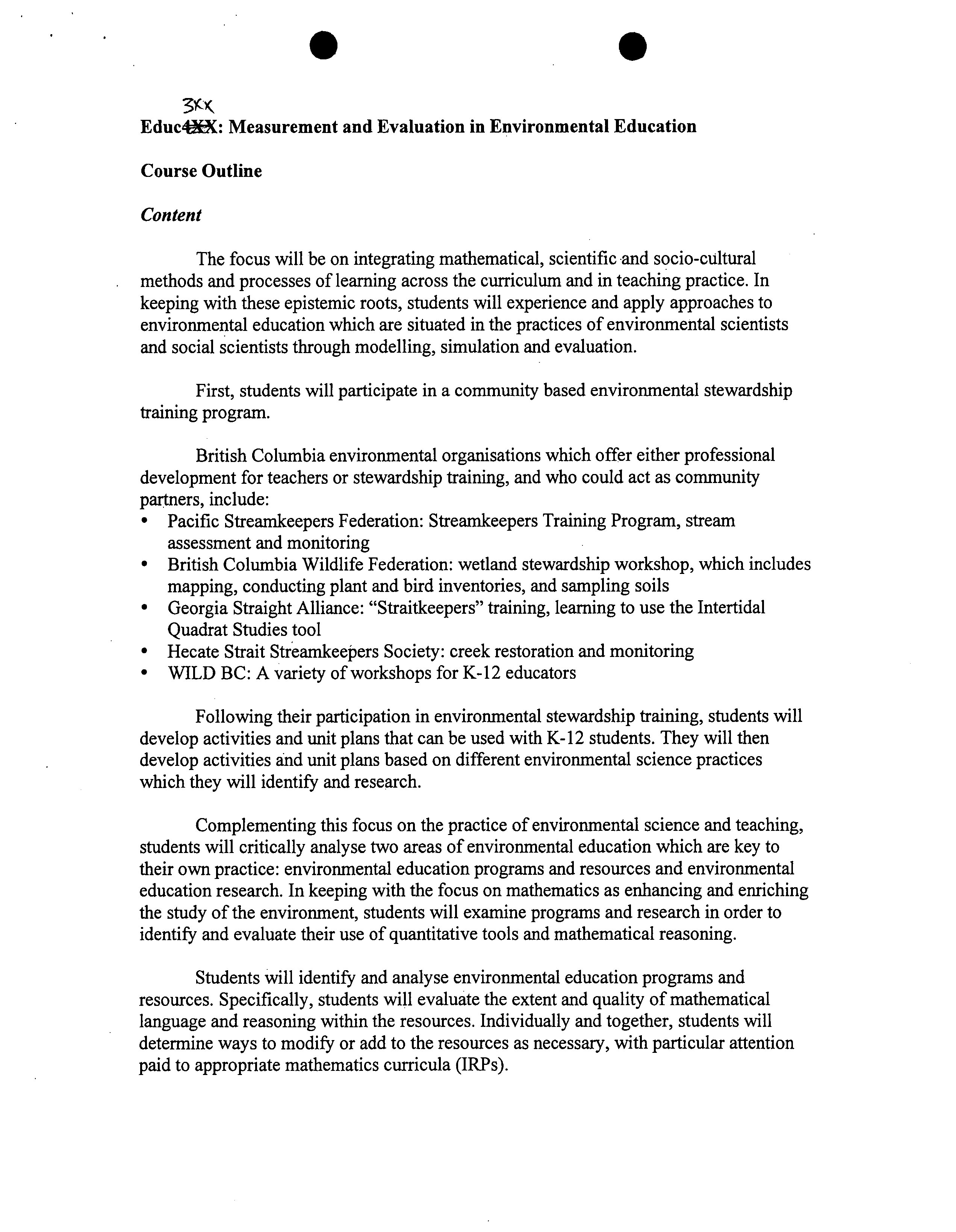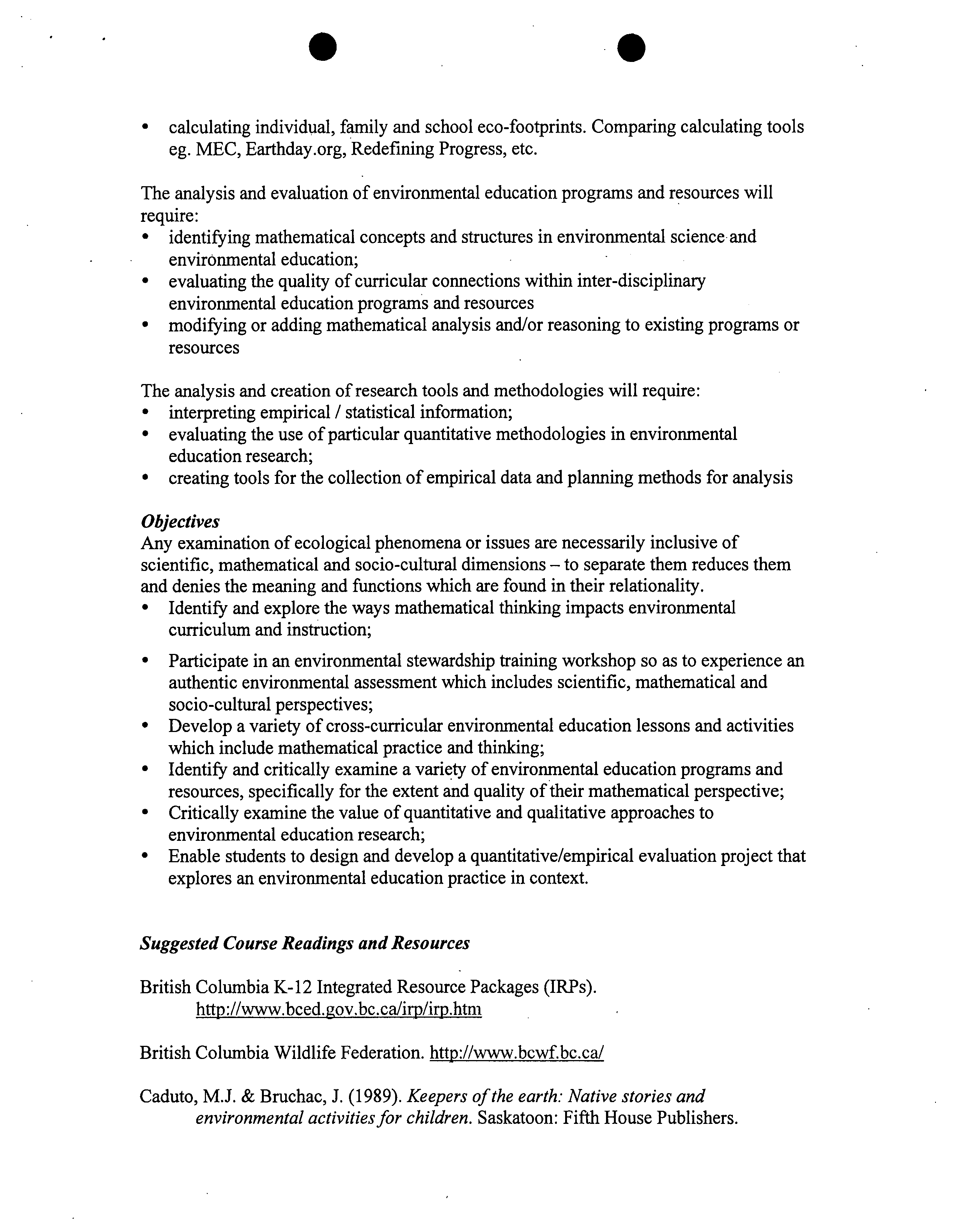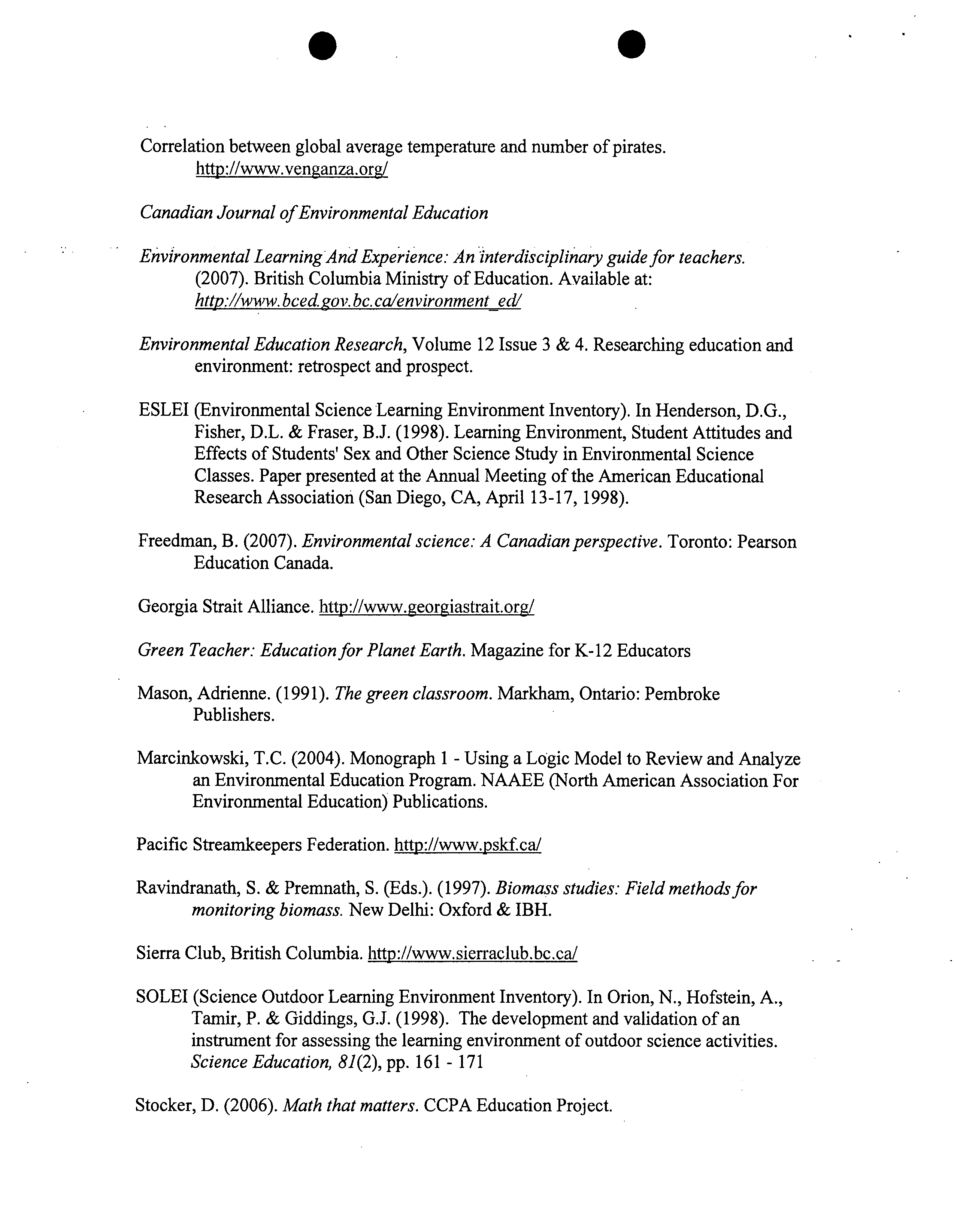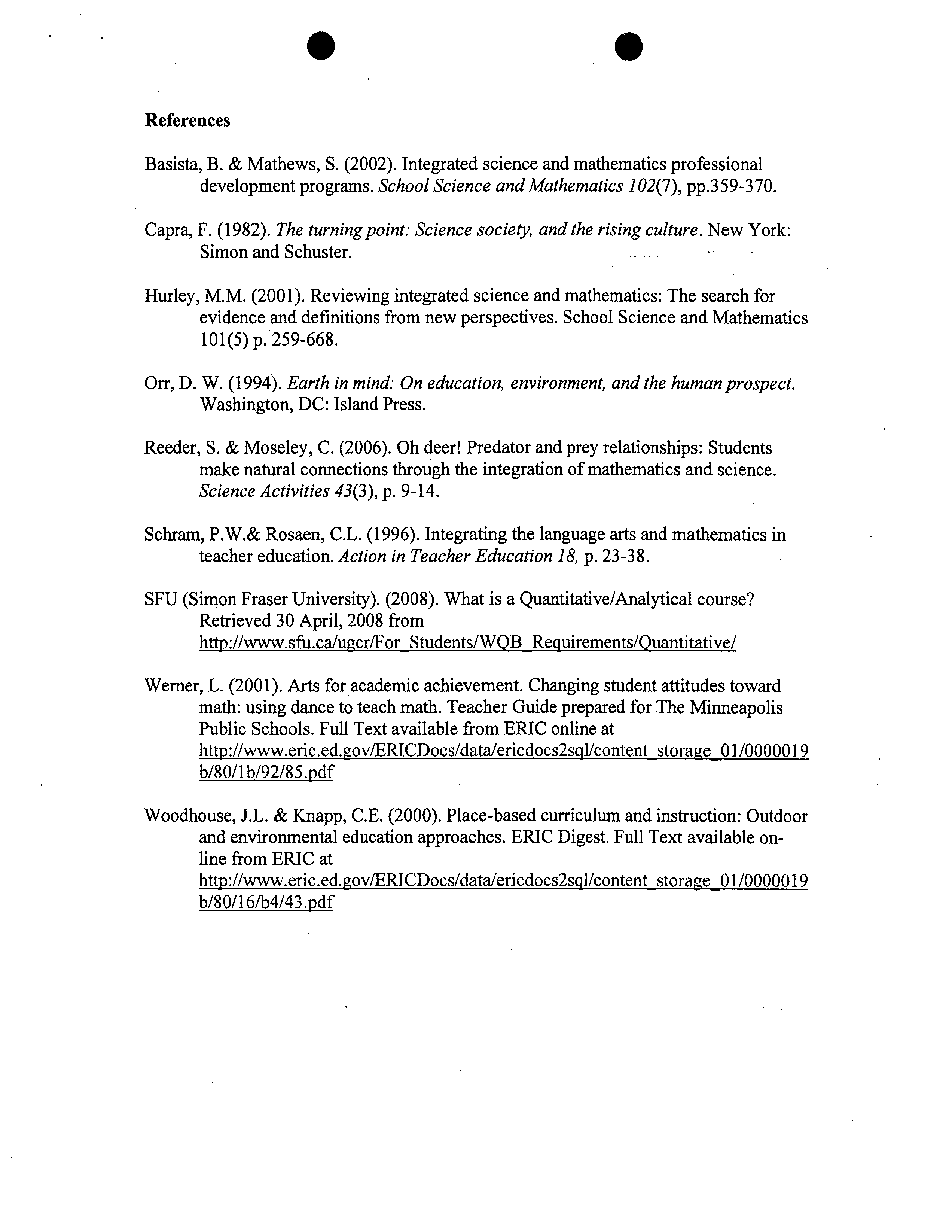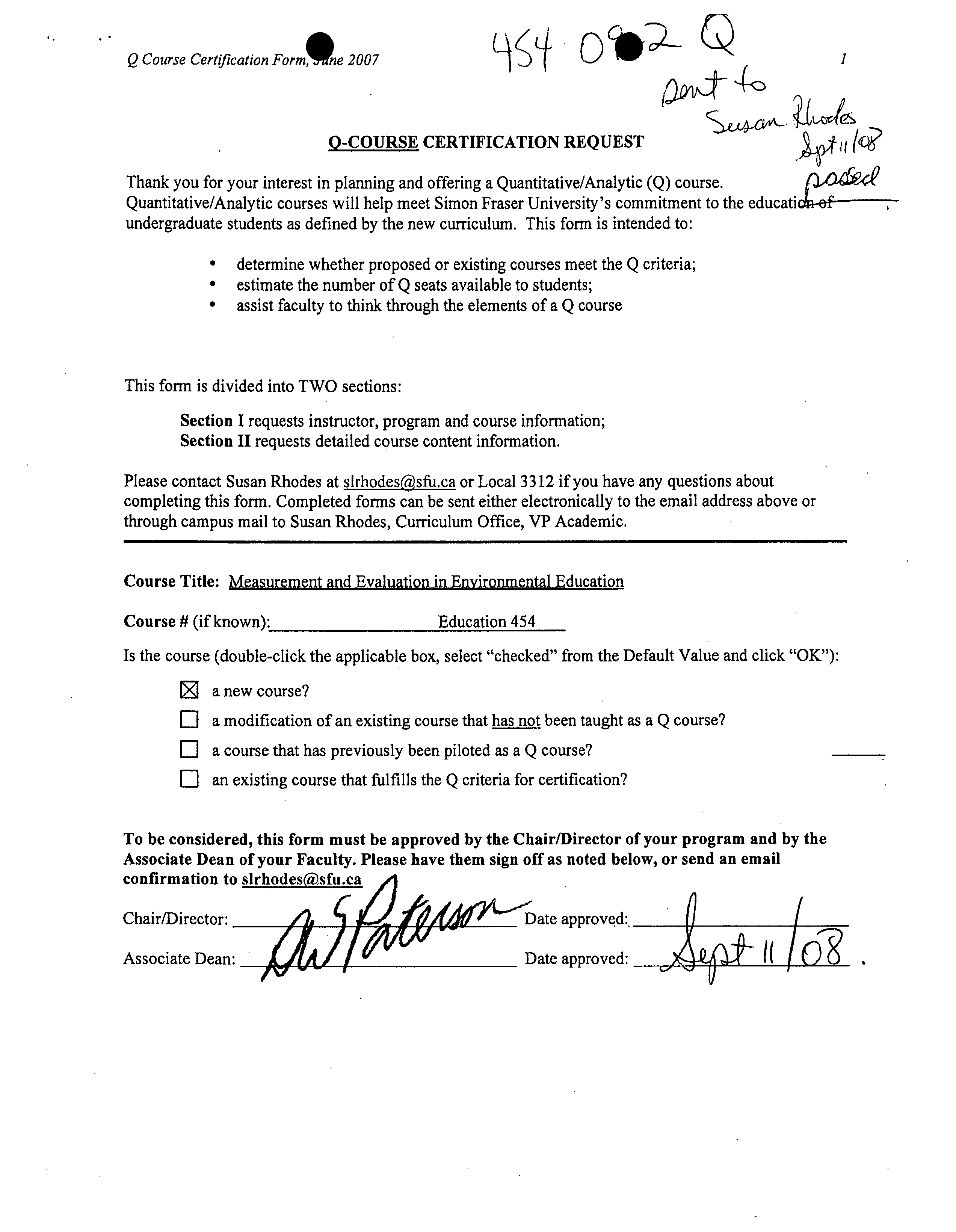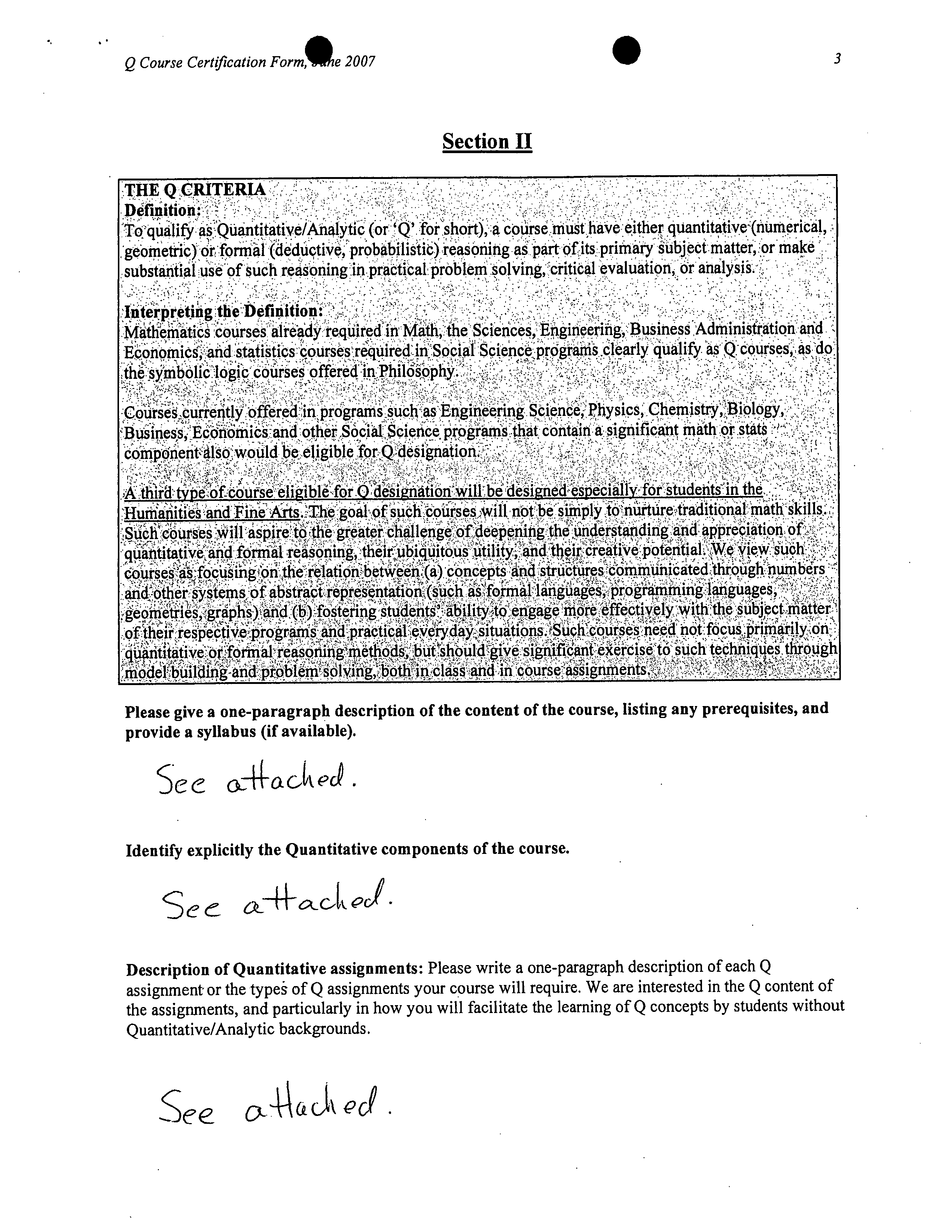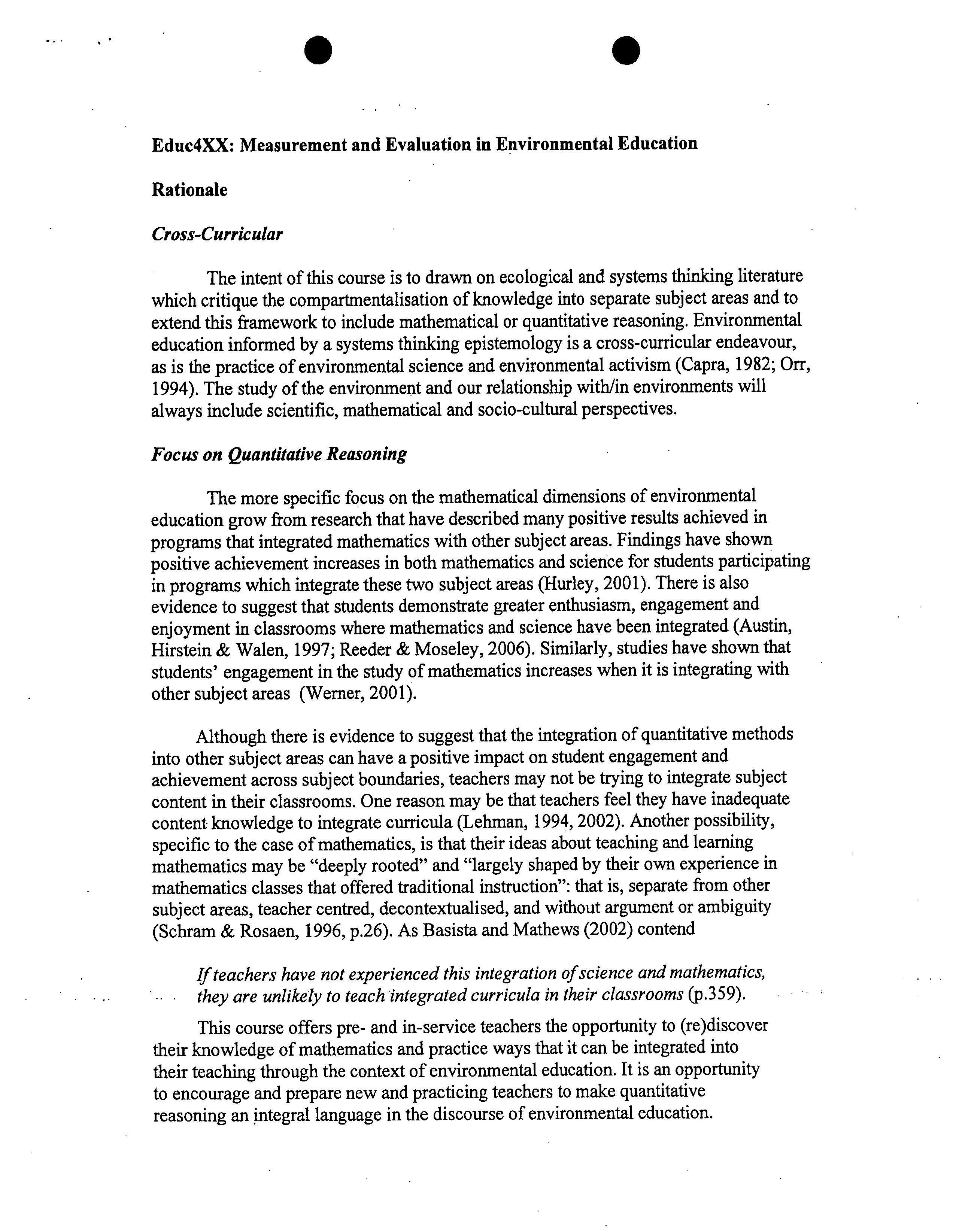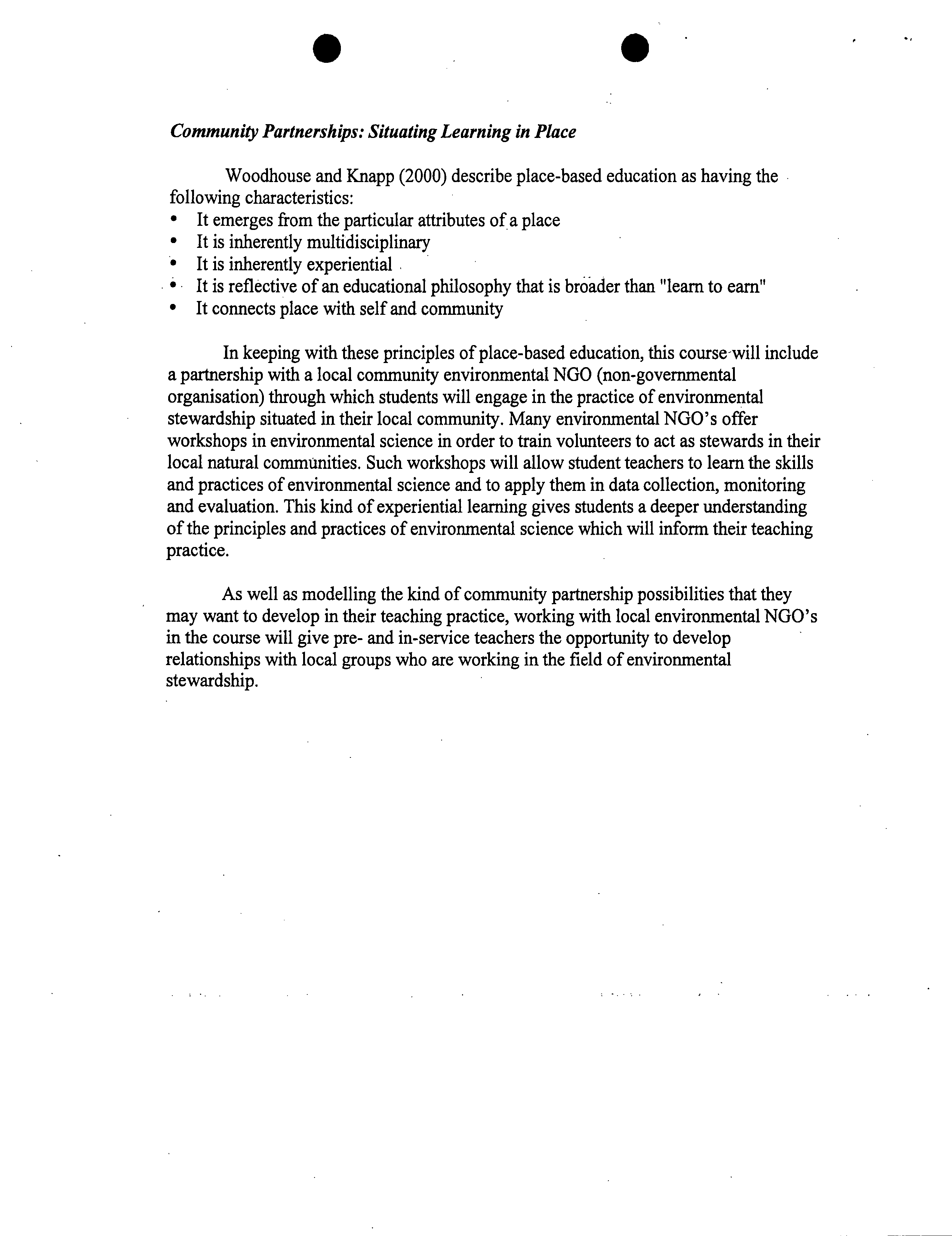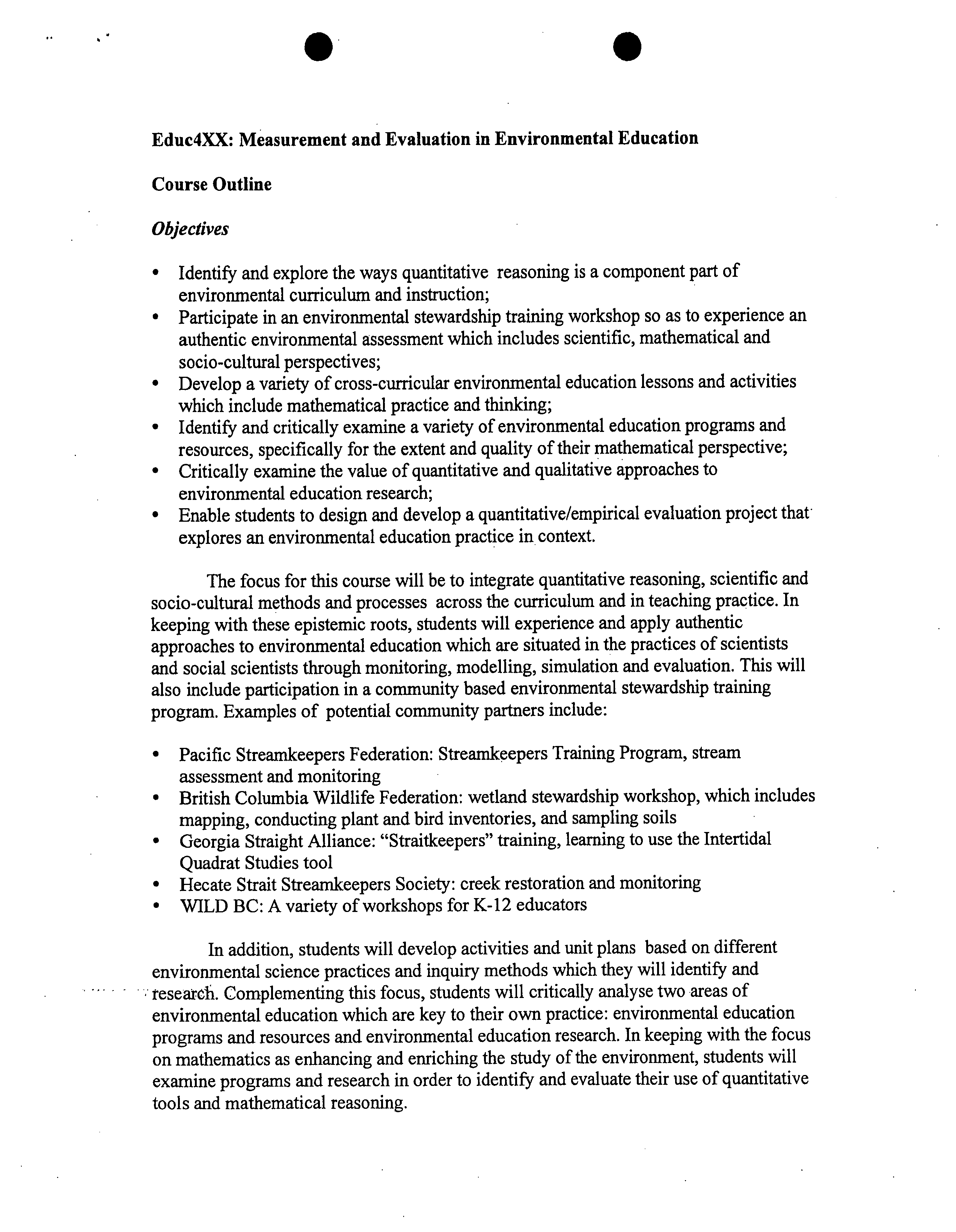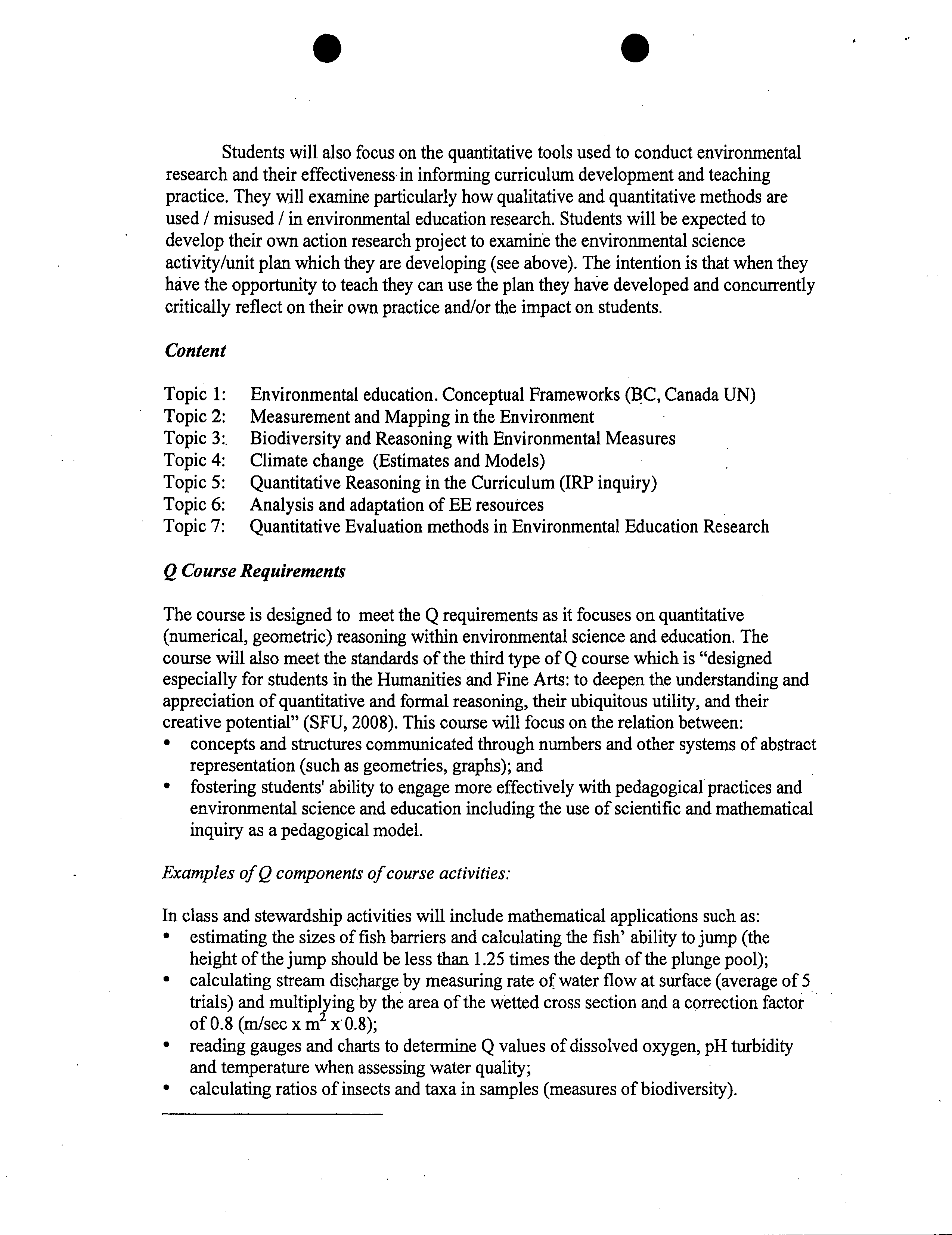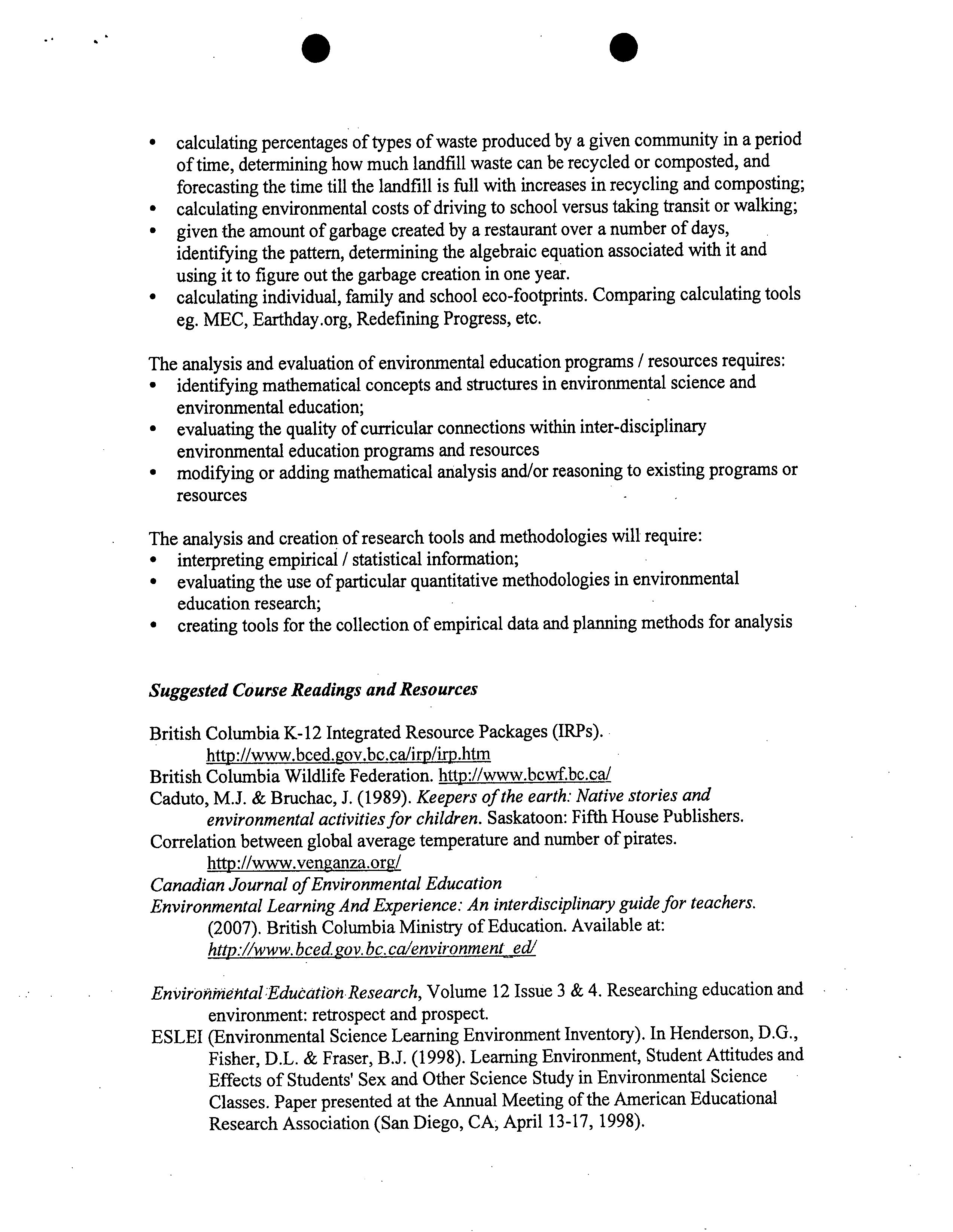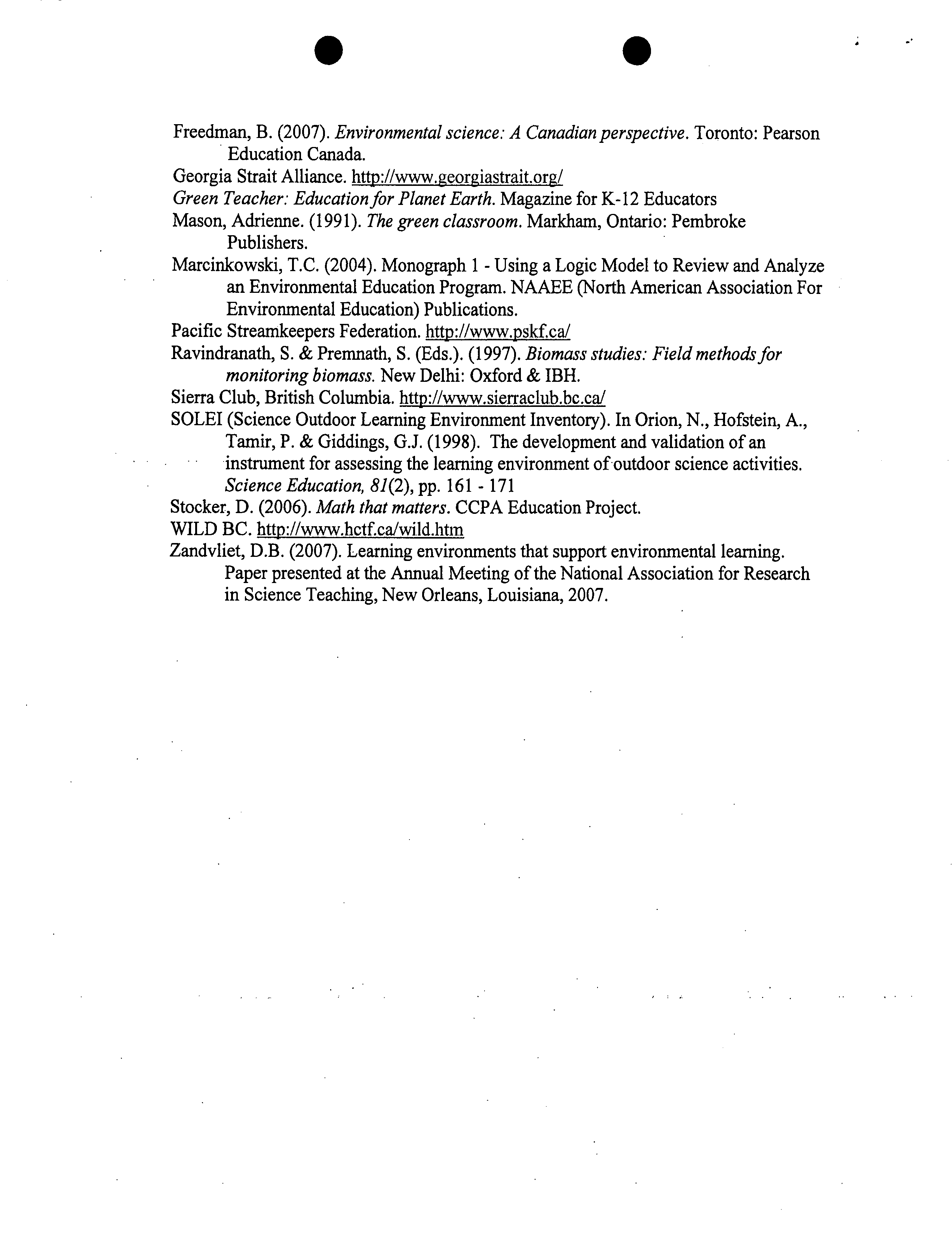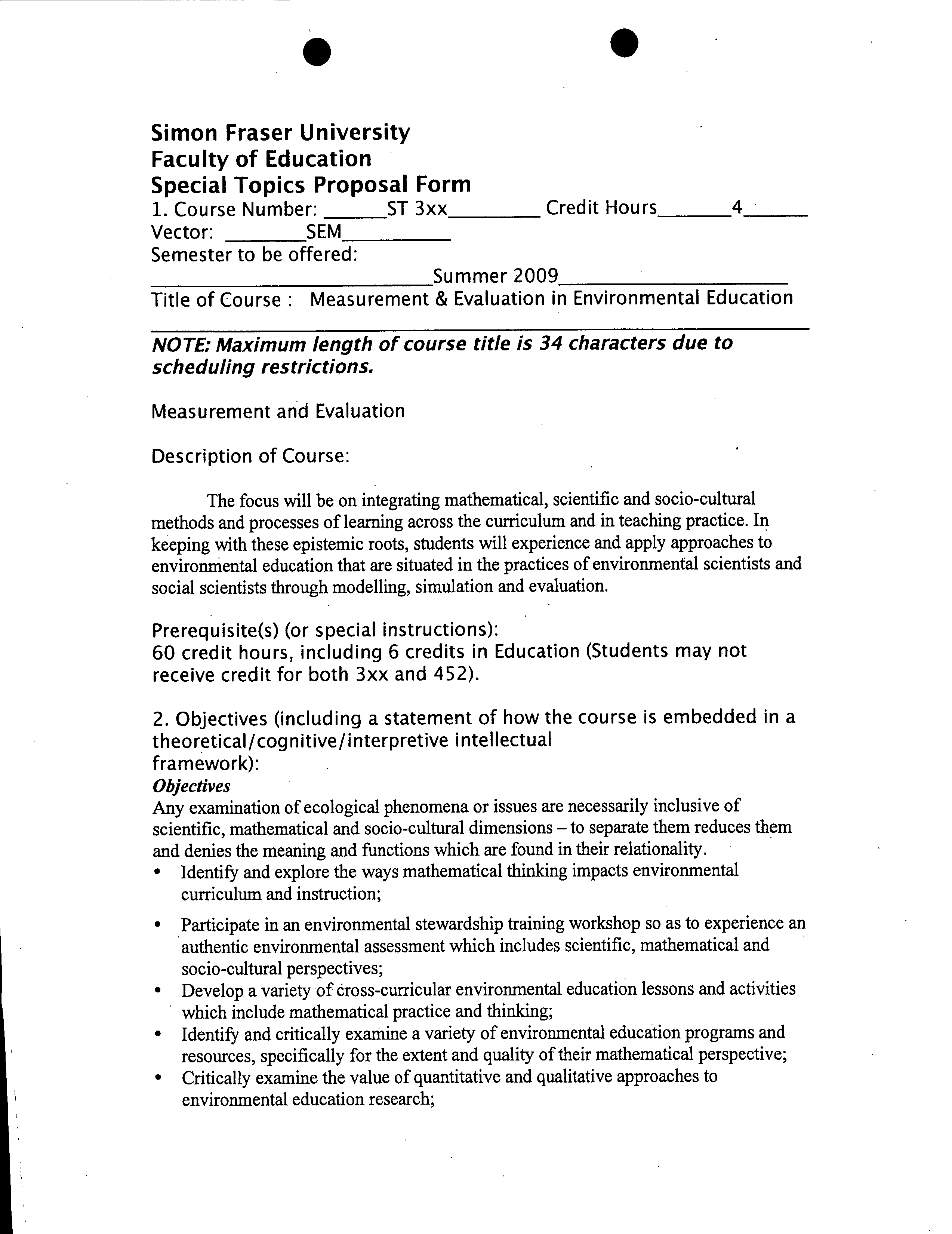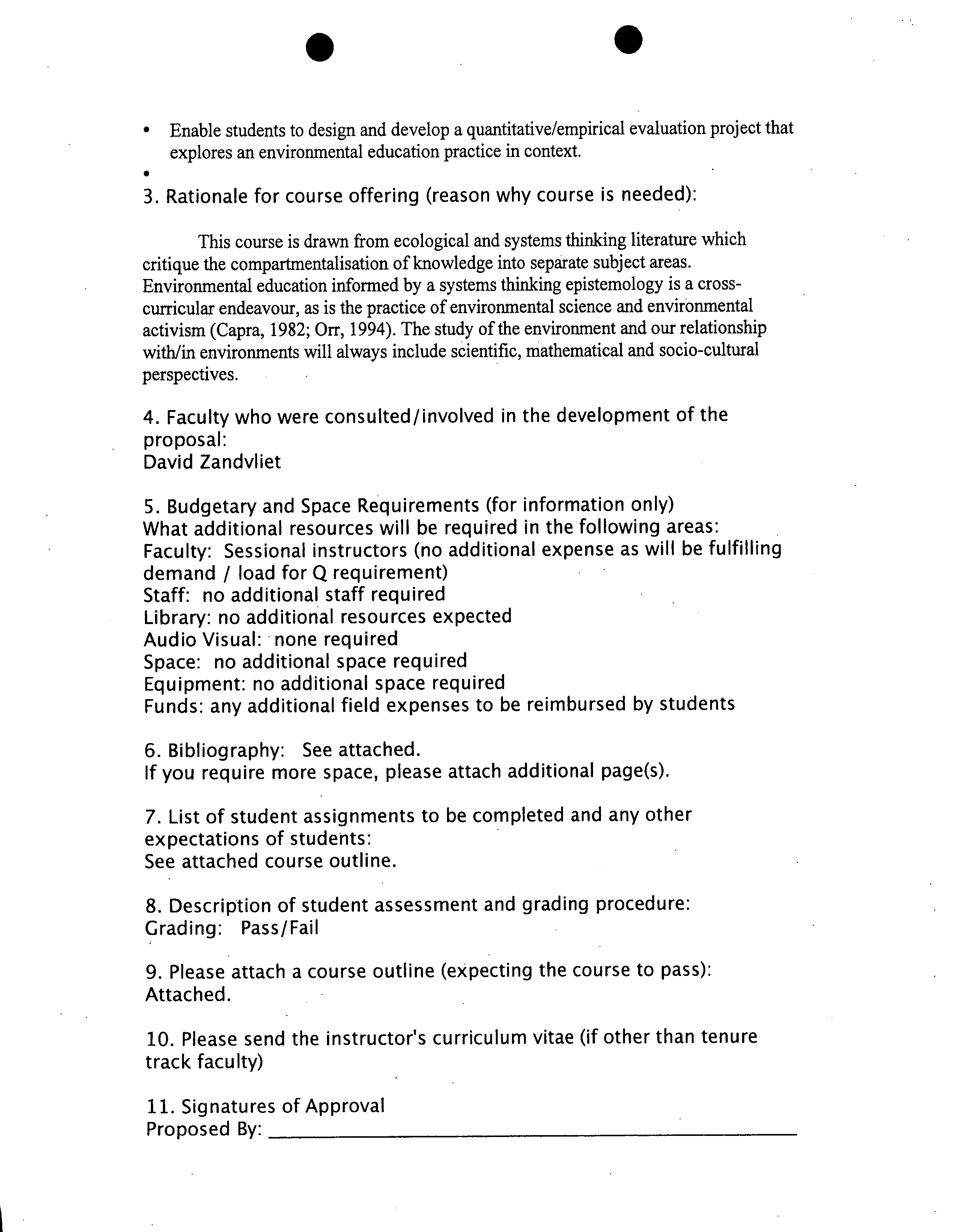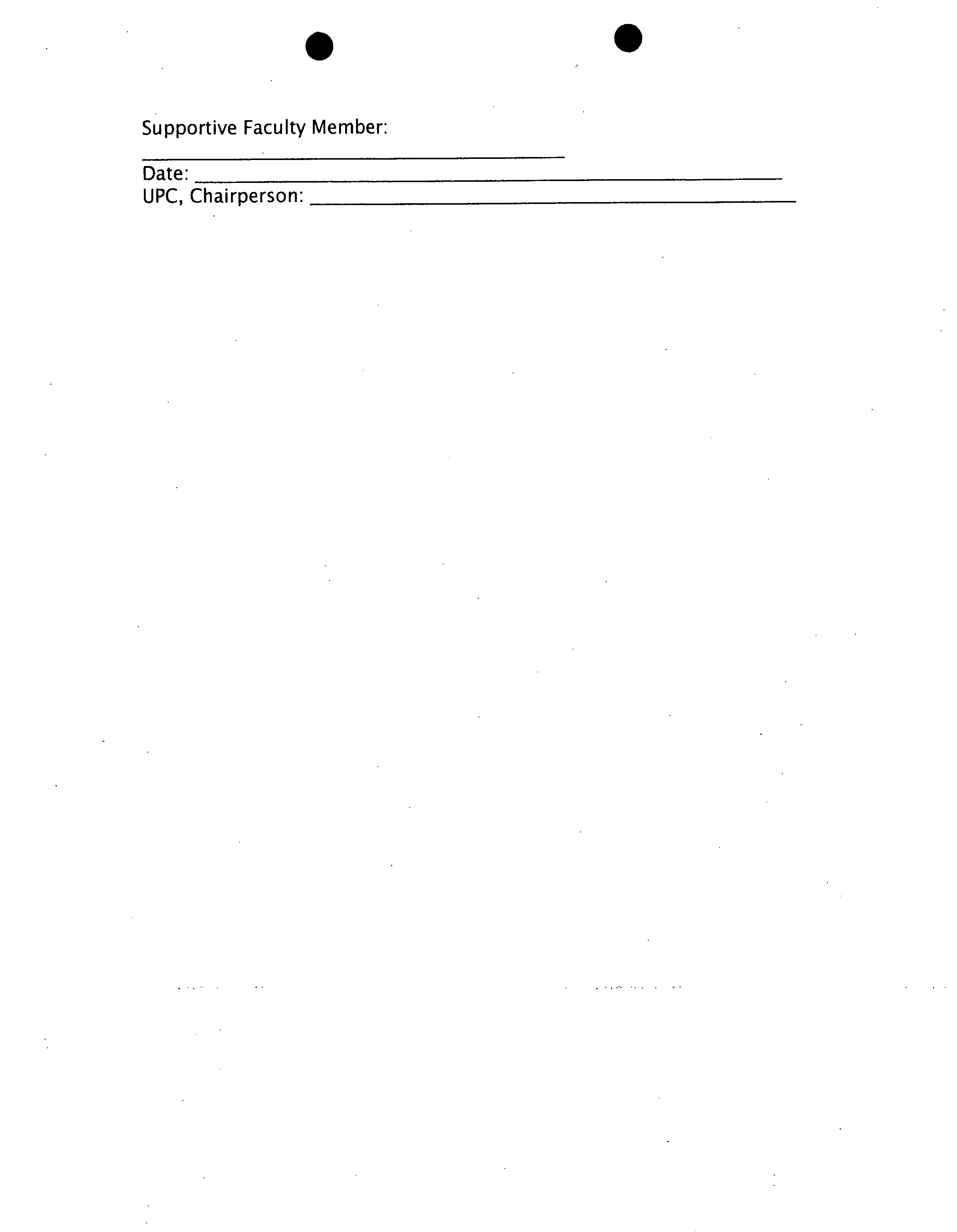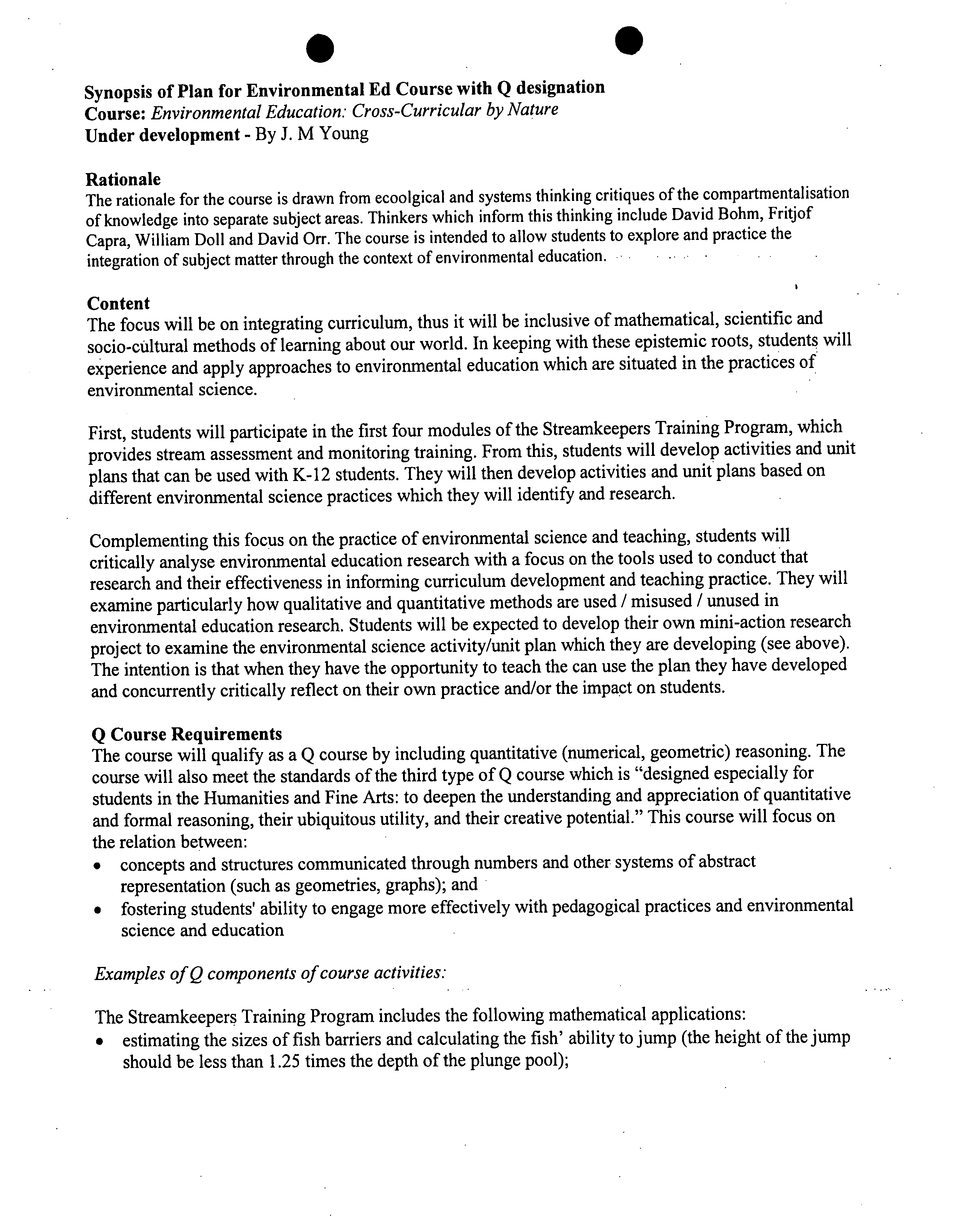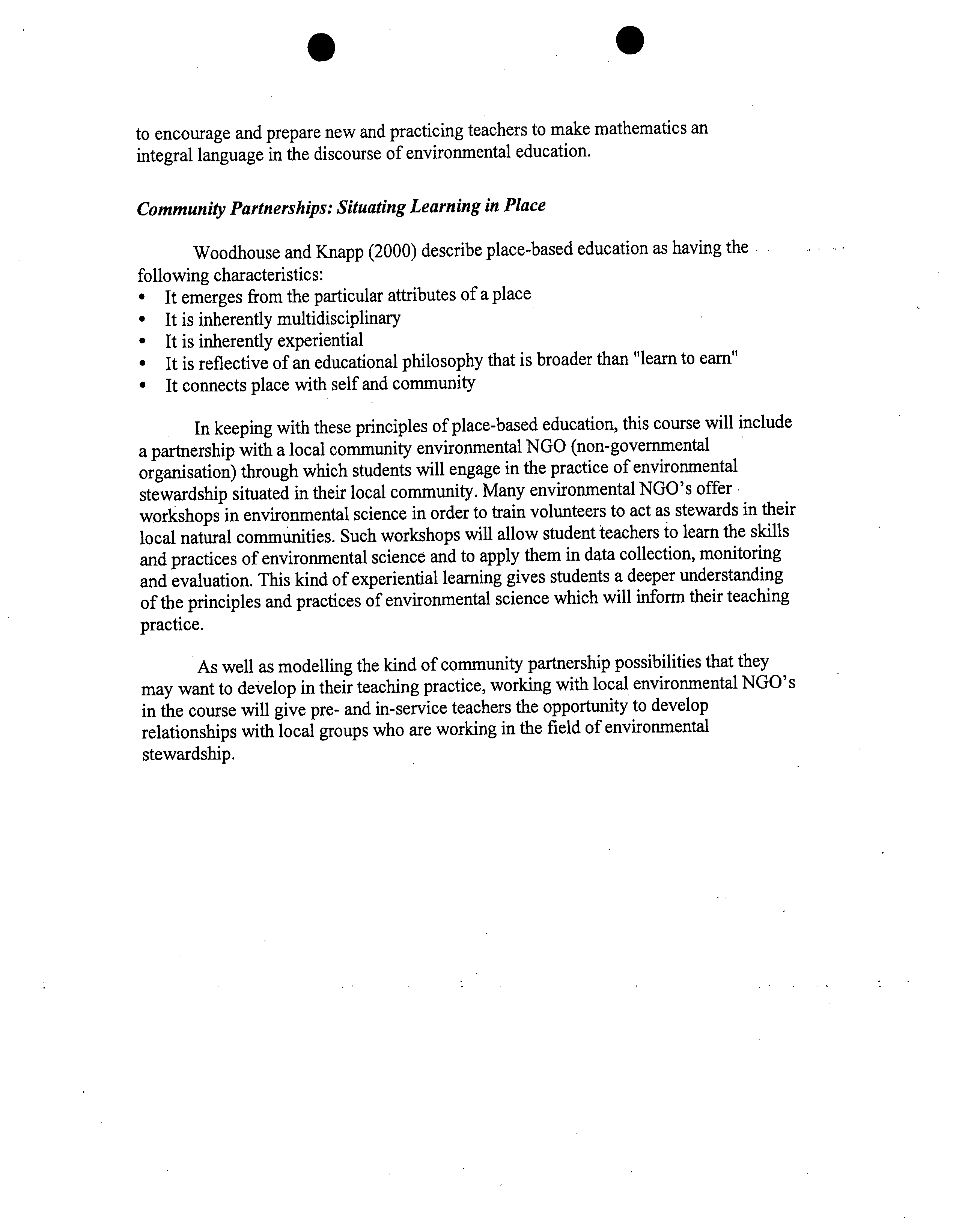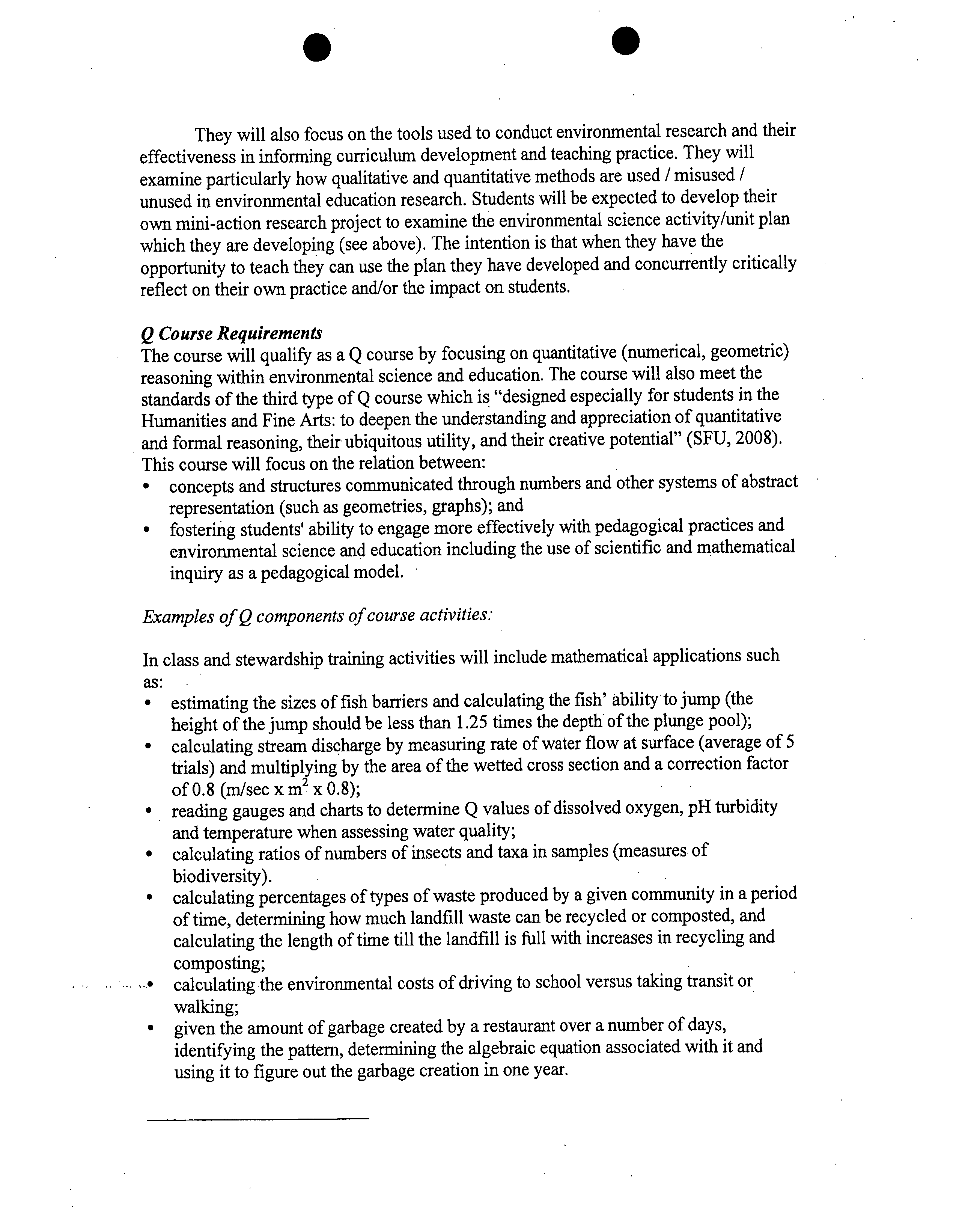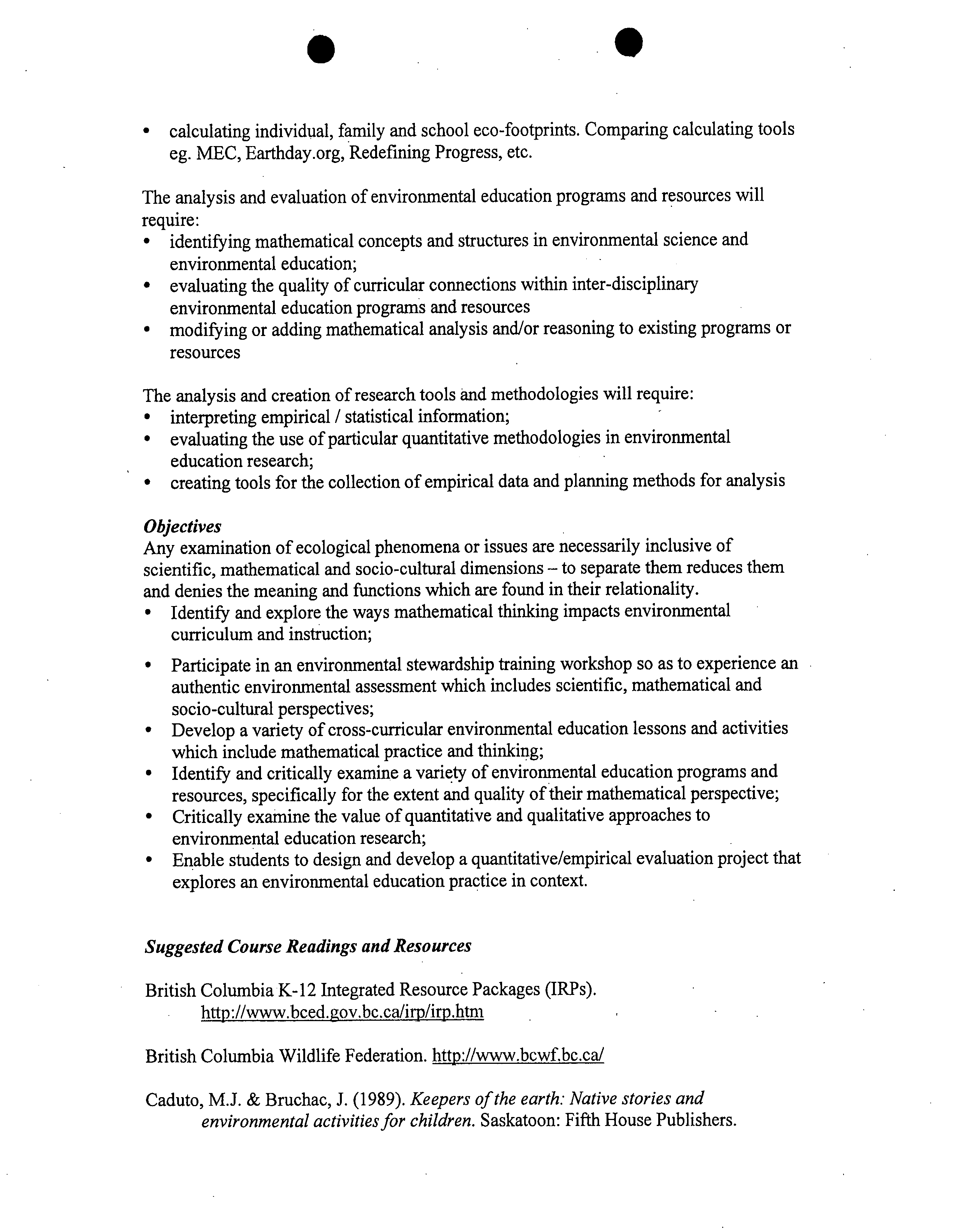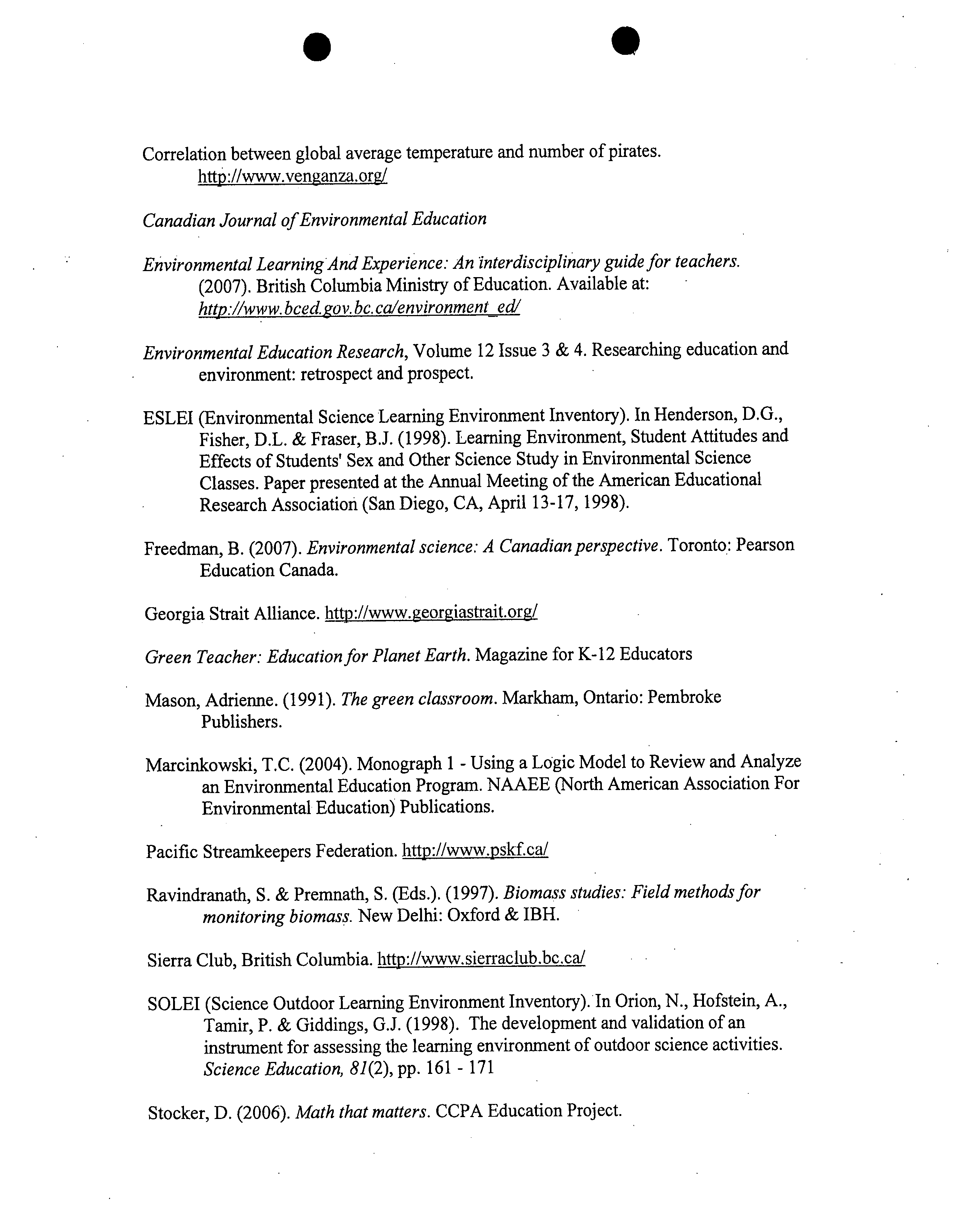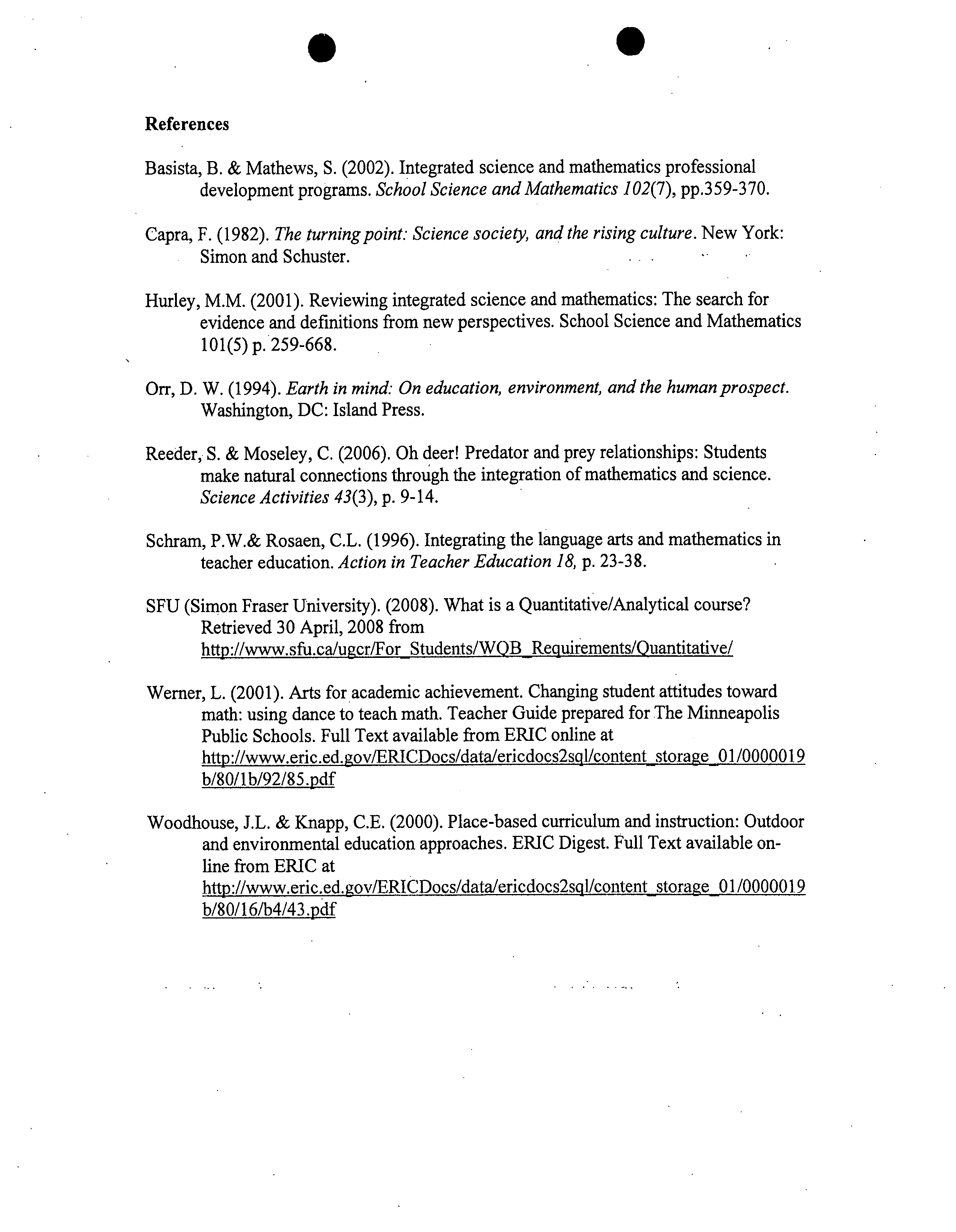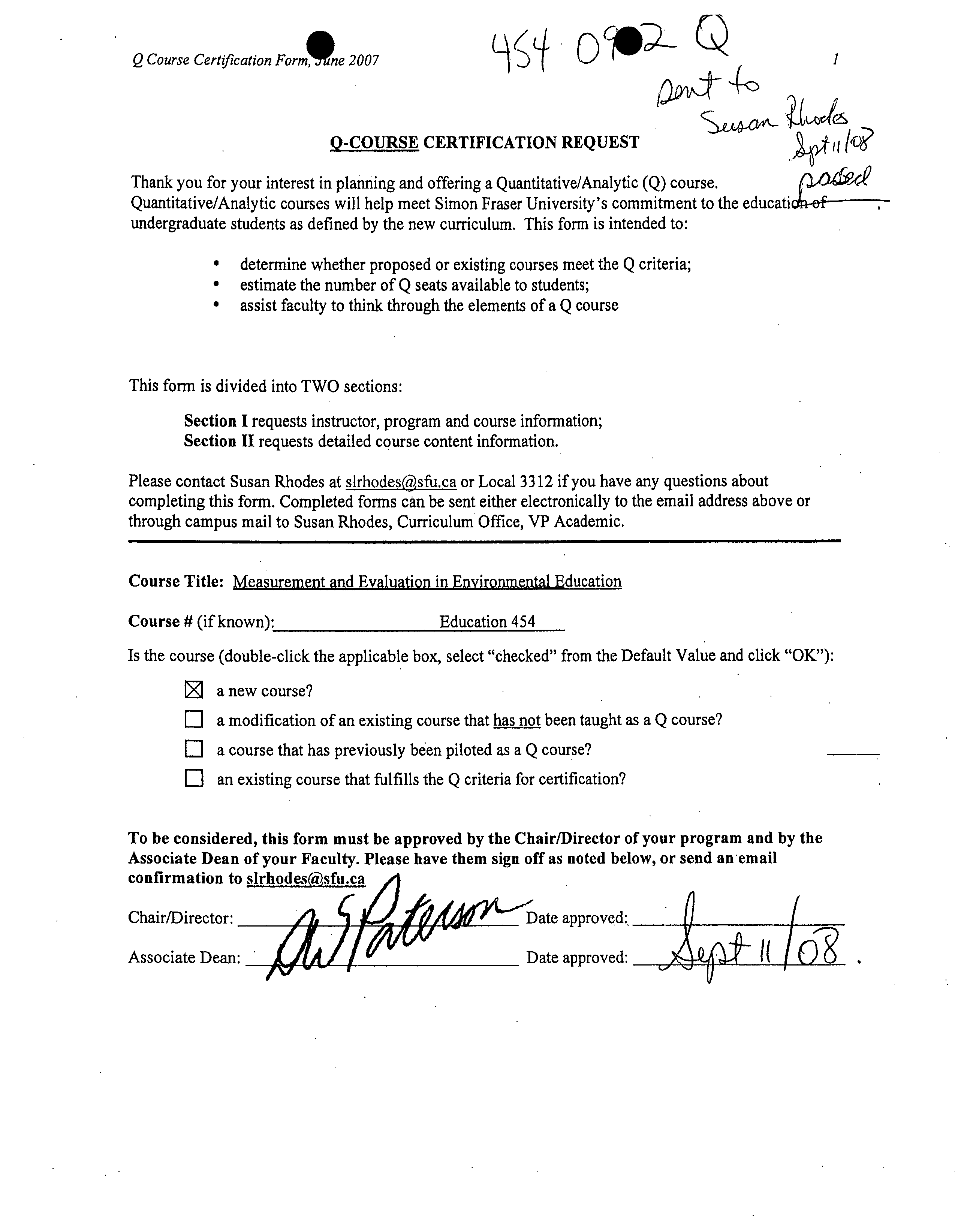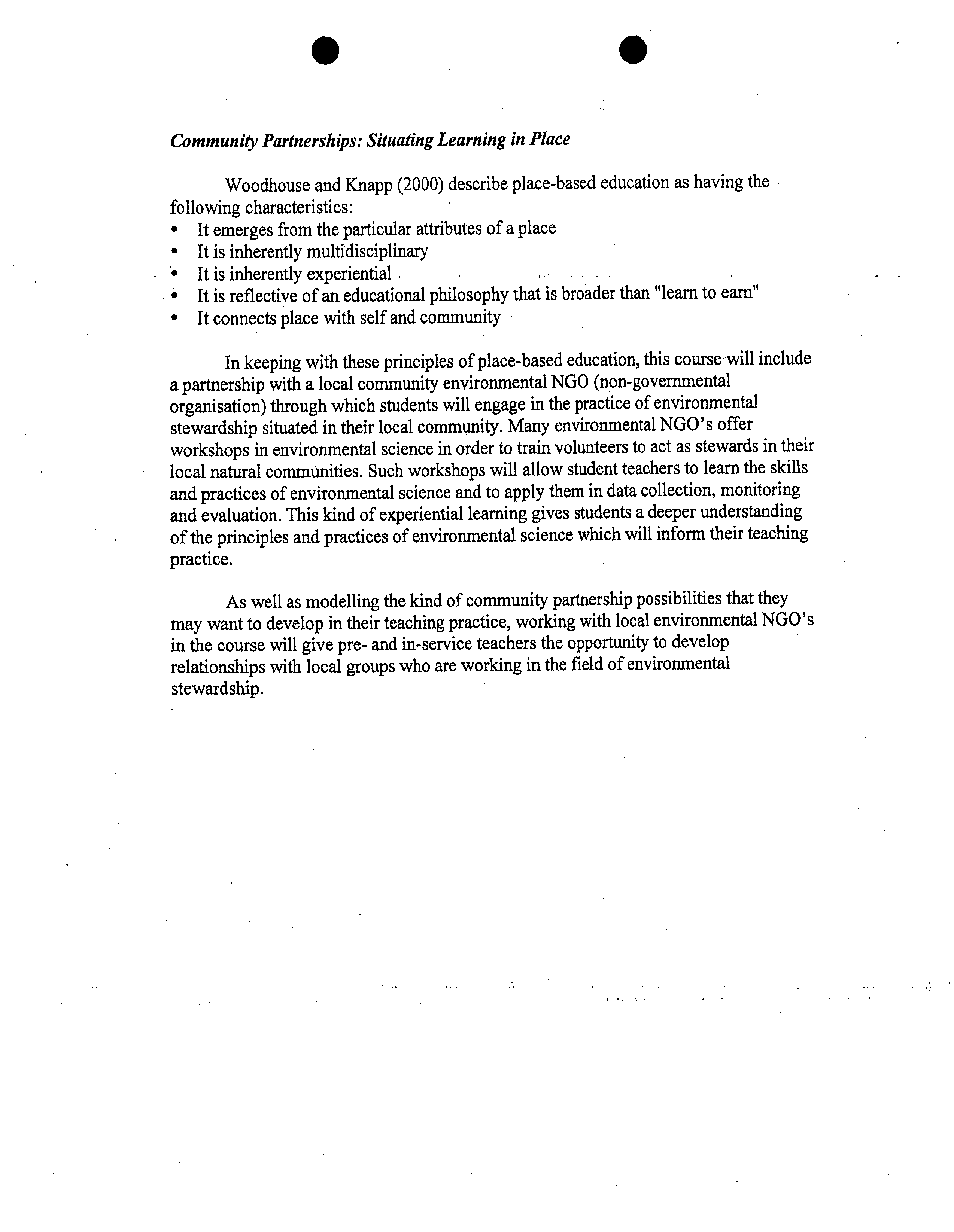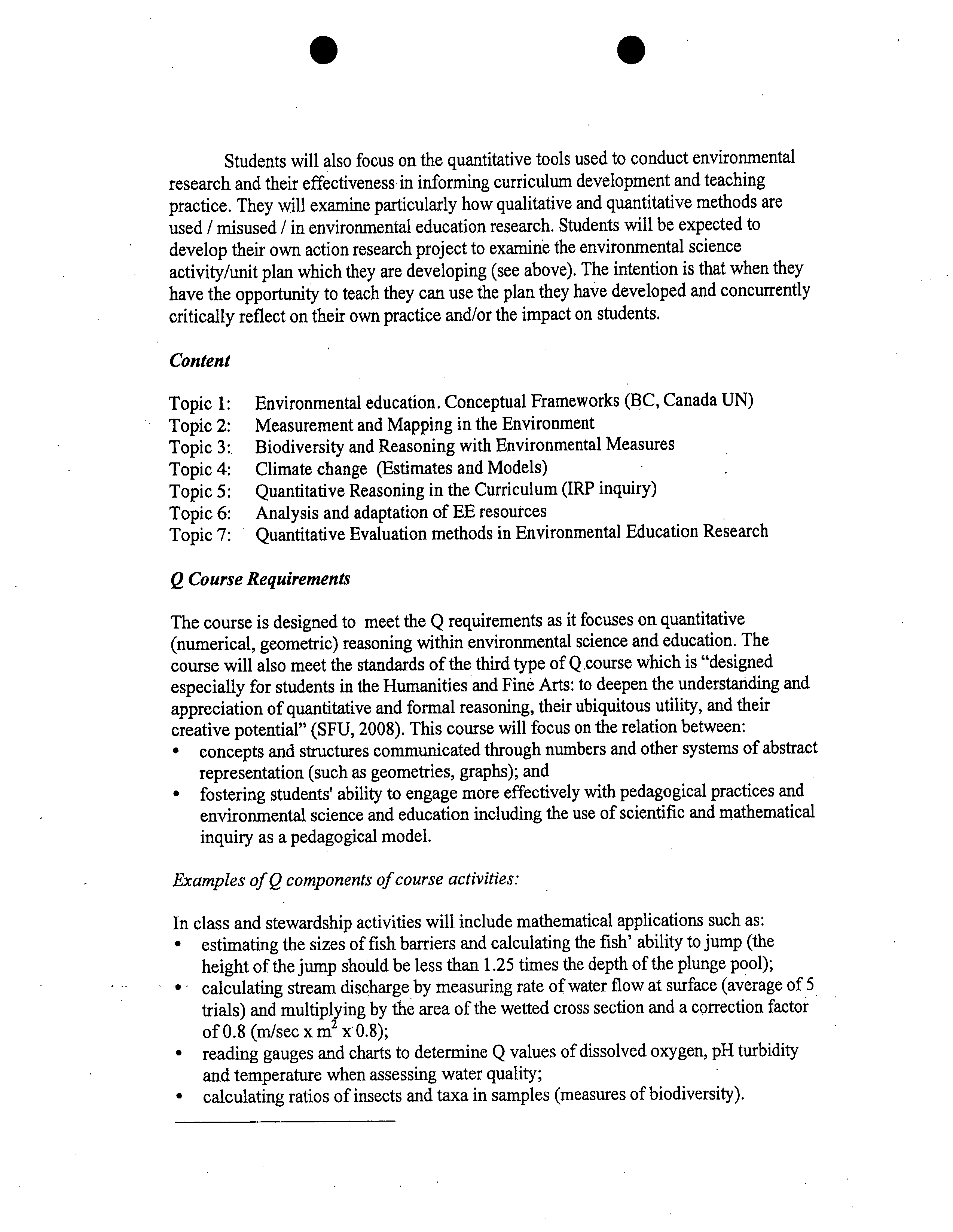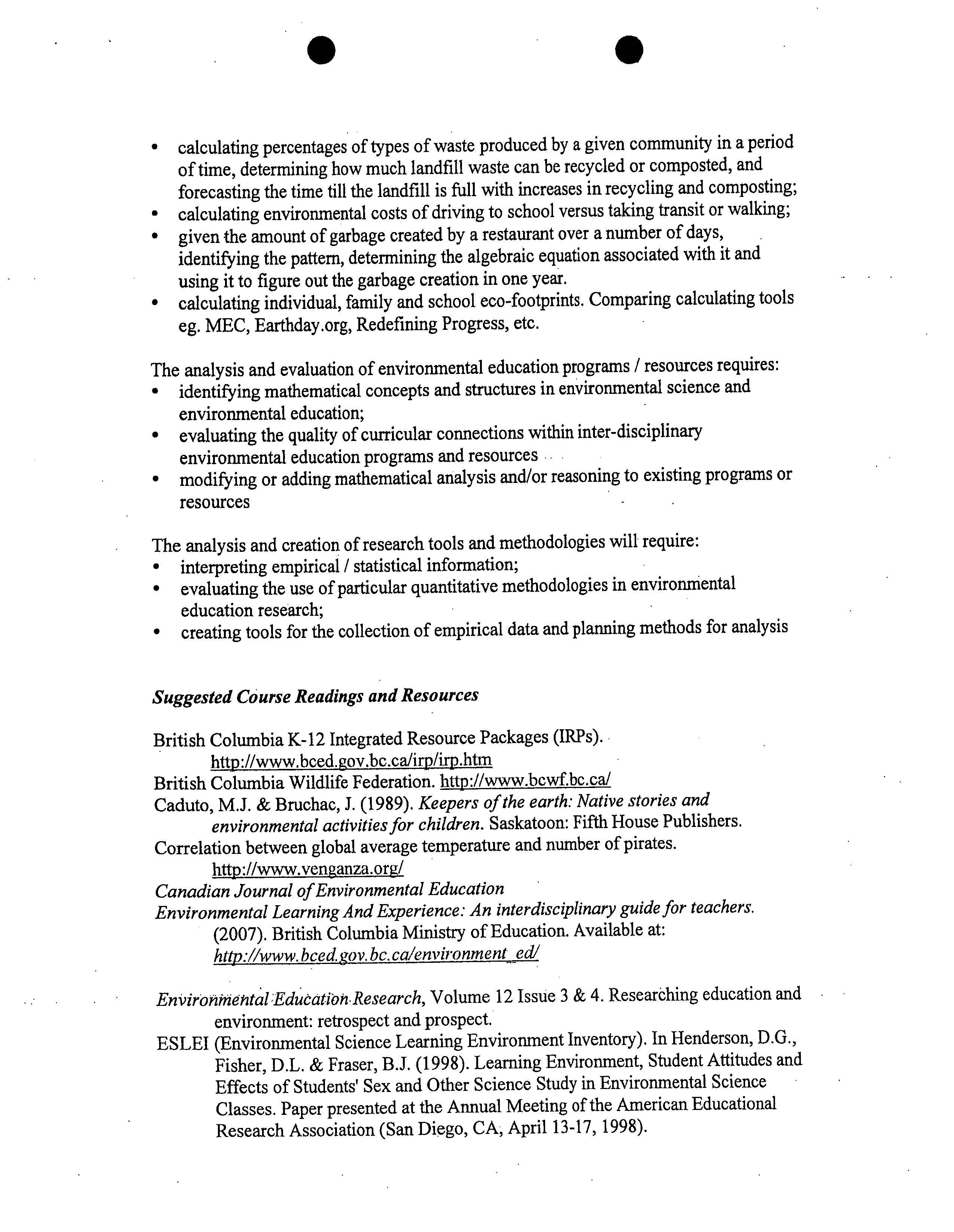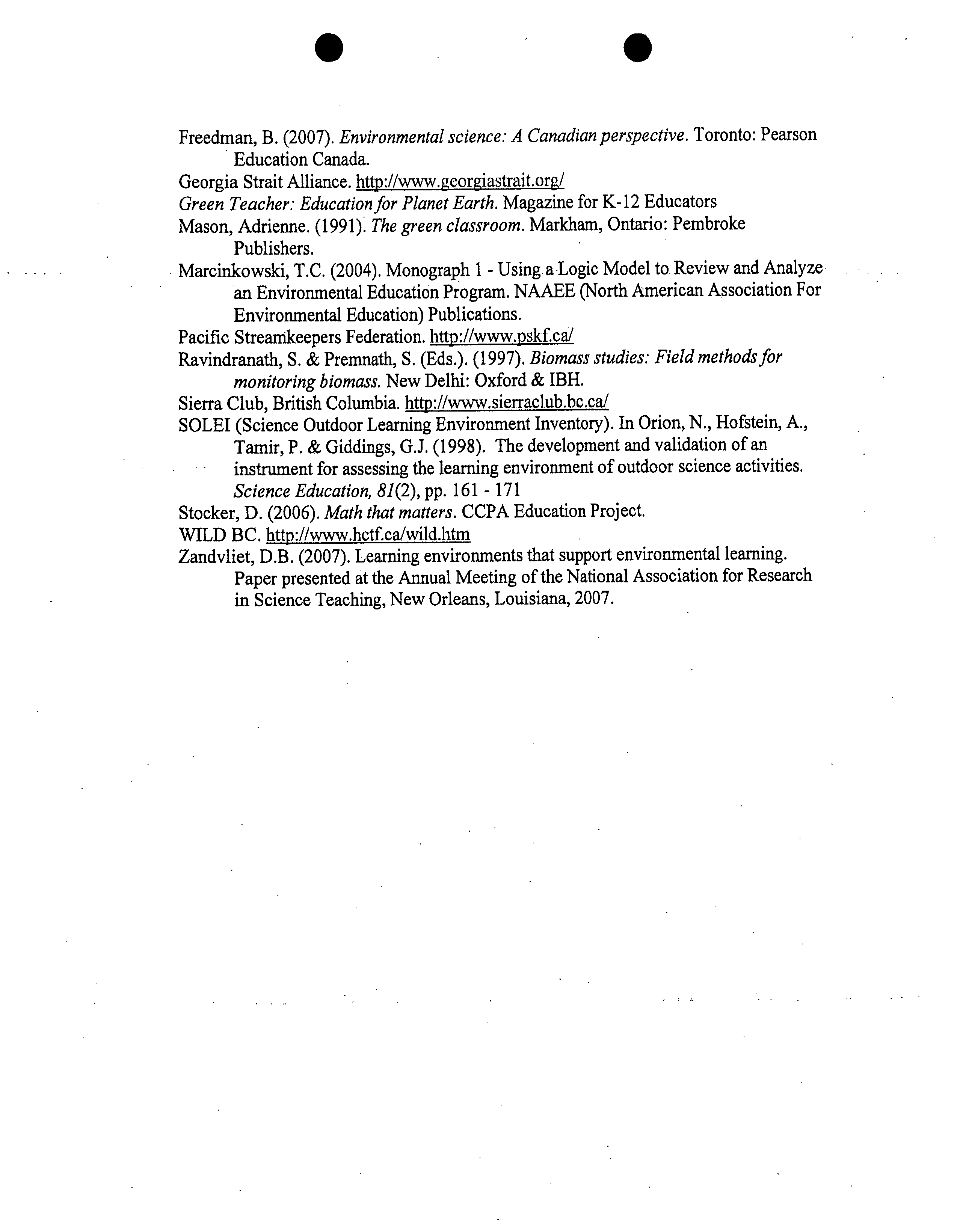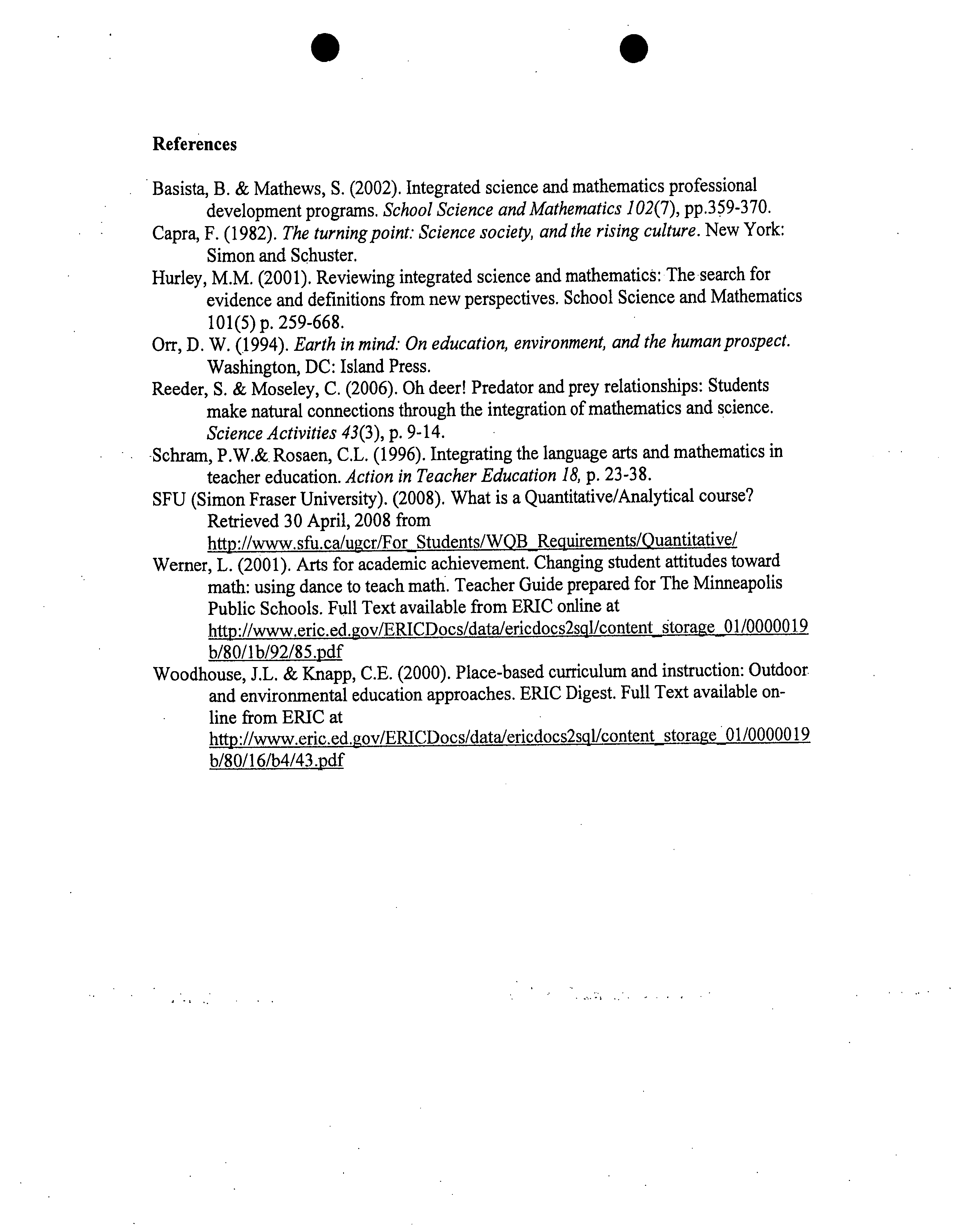/
EDUC Outline ?
http://www.educ.sU*gradprogs/course—listings/Educ454zandvliet...
.
?
SIMON FRASER UNIVERSITY
SUMMER INTERSESSION 2009
EDUC
454-4?
MEASUREMENT AND EVALUATION IN
ENVIRONMENTAL EDUCATION ?
(E100)
David Zandvl let ?
604-802-0036?
email: dbz@sfu.ca
Lower Mainland (F/SaJSu, May 8/9/10; 15/16/17; Jun 12/13/14)
Harbour Centre Room 1505
Friday - 4:30-8:20 pm
Saturday - 8:30-4:20
Sunday - 8:30-4:20
PREREQUISITE
EDUC 401/402 (or permission from the instructor)
COURSE DESCRIPTION
The focus will be on integrating mathematical, scientific and socio-cultural methods and processes of
learning across the curriculum and in teaching practice. In keeping with these epistemic roots, students
will experience and apply approaches to environmental education that are situated in the practices of
environmental scientists and social scientists through modelling, simulation and evaluation.
COURSE OBJECTIVES
In this course students will:
- Explore the ways mathematical thinking impacts environmental curriculum and instruction;
- Participate in a stewardship training workshop / authentic environmental assessment which includes
scientific, mathematical and socio-cultural perspectives;
- Develop a variety of cross-curricular environmental education lessons and activities which include
mathematical practice and thinking;
- Identify and critically examine a variety of environmental education programs and resources,
specifically for the extent and quality of their mathematical perspective;
- Critically examine different approaches to environmental education research;
- Design and develop a quantitative/empirical evaluation project that explores an environmental
education practice in context.
REQUIREMENTS
Students will complete the following course assignments and will be graded on a Pass/Fail basis:
- Attend an information session prior to the course start date (to be scheduled April 21, 2009)
- Develop lesson plans for the educational use of EE resources (mathematical reasoning focus)
- Develop a strategy for Environmental Education at the classroom, school or district level
Is ?
- Prepare a portfolio of their own design that may include aspects of all of the above plus demonstrates
a mastery of concepts and experiences component to the course
lof2 ?
2/11/09 9:29 AM
EDUC Outline
?
http://www.educ.sl*gradprogs/course—listings/Educ454zandvliet...
COURSE READINGS
•. ?
Readings will be provided from a variety government, on-line sources and current education journals.
There will be no textbook, however there is an
activity fee of
$200 dollars
to cover Fieldtrip and retreat
expenses. Students should also budget a small amount for copying.
NOTE?
A mandator y
information session is scheduled for Tuesda
y A p
ril 21st (time and location TBA)
.
is
2of2 ?
2/11/09 9:29 AM
A
?
.
?
S
Simon Fraser University
Faculty of Education
Special Topics Proposal Form
1.
Course Number:
? ST 3xx
?
Credit Hours4
Vector: ?
SEM___________
Semester to be offered:
Summer 2009
Title of Course : Measurement & Evaluation in Environmental Education
NOTE: Maximum length of course title is 34 characters due to
scheduling restrictions.
Measurement and Evaluation
Description of Course:
The focus will be on integrating mathematical, scientific and socio-cultural
methods and processes of learning across the curriculum and in teaching practice. In
keeping with these epistemic roots, students will experience and apply approaches to
environmental education that are situated in the practices of environmental scientists and
social scientists through modelling, simulation and evaluation.
Prerequisite(s) (or special instructions):
60 credit hours, including 6 credits in Education (Students may not
receive credit for both 3xx and 452).
2.
Objectives (including a statement of how the course is embedded in a
theoretical/cognitive/interpretive intellectual
framework):
Objectives
Any examination of ecological phenomena or issues are necessarily inclusive of
scientific, mathematical and socio-cultural dimensions - to separate them reduces them
and denies the meaning and functions which are found in their relationality.
• Identify and explore the ways mathematical thinking impacts environmental
curriculum and instruction;
• Participate in an environmental stewardship training workshop so as to experience an
authentic environmental assessment which includes scientific, mathematical and
socio-cultural perspectives;
• Develop a variety of cross-curricular environmental education lessons and activities
which include mathematical practice and thinking;
• Identify and critically examine a variety of environmental education programs and
resources, specifically for the extent and quality of their mathematical perspective;
• Critically examine the value of quantitative and qualitative approaches to
environmental education research;
S
?
S
• Enable students to design and develop a quantitative/empirical evaluation project that
explores an environmental education practice in context.
•
3.
Rationale for course offering (reason why course is needed):
This course is drawn from ecological and systems thinking literature which
critique the compartmentalisation of knowledge into separate subject areas.
Environmental education informed by a systems thinking epistemology is a cross-
curricular endeavour, as is the practice of environmental science and environmental
activism (Capra, 1982; Orr, 1994). The study of the environment and our relationship
with/in environments will always include scientific, mathematical and socio-cultural
perspectives.
4.
Faculty who were consulted/involved in the development of the
proposal:
David Zandvliet
5. Budgetary and Space Requirements (for information only)
What additional resources will be required in the following areas:
Faculty: Sessional instructors (no additional expense as will be fulfilling
demand / load for
Q
requirement)
Staff: no additional staff required
Library: no additional resources expected
Audio Visual: none required
Space: no additional space required
Equipment: no additional space required
Funds: any additional field expenses to be reimbursed by students
6.
Bibliography: See attached.
If you require more space, please attach additional page(s).
7.
List of student assignments to be completed and any other
expectations of students:
See attached course outline.
8. Description of student assessment and grading procedure:
Grading: Pass/Fail
9.
Please attacha course outline (expecting the course to pass):
Attached.
10.
Please send the instructor's curriculum vitae (if other than tenure
track faculty)
11. Signatures of Approval
Proposed By:
S ?
S
Supportive Faculty Member:
Date:
UPC, Chairperson:
.
?
S
Synopsis of Plan for Environmental Ed Course with
Q
designation
Course:
Environmental Education: Cross-Curricular by Nature
Under development -
By J. M Young
Rationale
The rationale for the course is drawn from ecoolgical and systems thinking critiques of the compartmentalisation
of knowledge into separate subject areas. Thinkers which inform this thinking include David Bohm, Fritjof
Capra, William Doll and David Orr. The course is intended to allow students to explore and practice the
integration of subject matter through the context of environmental education. ........
Content
The focus will be on integrating curriculum, thus it will be inclusive of mathematical, scientific and
socio-cultural methods of learning about our world. In keeping with these epistemic roots, students will
experience and apply approaches to environmental education which are situated in the practices of
environmental science.
First, students will participate in the first four modules of the Streamkeepers Training Program, which
provides stream assessment and monitoring training. From this, students will develop activities and unit
plans that can be used with K-12 students. They will then develop activities and unit plans based on
different environmental science practices which they will identify and research.
Complementing this focus on the practice of environmental science and teaching, students will
critically analyse environmental education research with a focus on the tools used to conduct that
research and their effectiveness in informing curriculum development and teaching practice. They will
examine particularly how qualitative and quantitative methods are used / misused / unused in
environmental education research. Students will be expected to develop their own mini-action research
project to examine the environmental science activity/unit plan which they are developing (see above).
The intention is that when they have the opportunity to teach the can use the plan they have developed
and concurrently critically reflect on their own practice and/or the impact on students.
Q
Course Requirements
The course will qualify as a
Q
course by including quantitative (numerical, geometric) reasoning. The
course will also meet the standards of the third type of
Q
course which is "designed especially for
students in the Humanities and Fine Arts: to deepen the understanding and appreciation of quantitative
and formal reasoning, their ubiquitous utility, and their creative potential." This course will focus on
the relation between:
• concepts and structures communicated through numbers and other systems of abstract
representation (such as geometries, graphs); and
• fostering students' ability to engage more effectively with pedagogical practices and environmental
science and education
Examples of Q components of course activities.
The Streamkeepers Training Program includes the following mathematical applications:
• estimating the sizes offish barriers and calculating the fish' ability to jump (the height of the jump
should be less than 1.25 times the depth of the plunge pool);
. ?
S
• calculating stream discharge by measuring rate of water flow at surface (average of
5
trials) and
multiplying by the area of the wetted cross section and a correction factor of 0.8 (m/sec x m
2
x 0.8);
• reading charts to determine Q values of dissolved oxygen, pH turbidity and temperature when
assessing water quality;
• calculating ratios of numbers of insects and taxa in samples.
Other environmental education activities will include mathematical applications such as:
• Calculating percentages of types of waste produced by a given community in a period of time,
determining how much landfill waste can be recycled or composted, and calculating the length of
time till the landfill is full with increases in recycling and composting;
• Calculating the environmental costs of driving to school versus taking transit or walking;
• Given the amount of garbage created by a restaurant over 4 days, identifying the pattern,
determining the algebraic equation associated with it and use it to figure out the garbage creation in
one year.
The analysis and creation of research tools and methodologies will require:
• Interpreting empirical / statistical information;
• Evaluating the use of particular quantitative methodologies in environmental education research;
• Creating tools for the collection of empirical data and planning methods for analysis
(Some) Objectives
Any examination of ecological phenomena or issues are necessarily inclusive of scientific,
mathematical and socio-cultural dimensions - to separate them reduces them and denies the meaning
and functions which are found in their relationality.
• Introduce students to the epistemological roots of ecological thinking;
• Identify and explore the ways ecological thinking impacts curriculum and instruction;
• Participate in the Pacific Streamkeeper' s Training Program so as to experience an authentic
environmental assessment which includes science, mathematics and socio-cultural perspectives;
• Develop a variety of cross-curricular environmental education lessons and activities;
• Critically examine the value of quantitative and qualitative approaches to environmental education
research;
• Enable students to design and develop a quantitative/empirical research project that explores an
environmental education practice.
Possible Assignments
Group cross-curricular unit plan development
Cross-curricular unit plan development
Mini-action research proposal
Paper: critique of environmental education research
Paper: rationale for cross-curricular environmental education
.
?
S
Educ4: Measurement and Evaluation in Environmental Education
Rationale
Cross-Curricular
The overall rationale for the course is drawn ecological and systems thinking
literature which critique the compartmentalisation of knowledge into separate subject
areas. Environmental education informed by a systems thinking epistemology is a cross-
curricular endeavour, as is the practice of environmental science and environmental
activism (Capra, 1982; Orr, 1994). The study of the environment and our relationship
with/in environments will always include scientific, mathematical and socio-cultural
perspectives.
Focus on Mathematics
The more specific focus on the mathematical dimensions of environmental
education grows from studies which have described the positive results achieved in
programs that integrated mathematics with other subject areas. Findings have shown
small but positive achievement increases in both mathematics and science for students
participating in programs which integrate these two subject areas (Hurley, 2001). There is
also evidence to suggest that students demonstrate greater enthusiasm, engagement and
enjoyment in classrooms where mathematics and science have been integrated (Austin,
Hirstein & Walen, 1997 as cited in Hurley, 2001; O'Neal, 1995 as cited in Hurley, 2001;
Reeder & Moseley, 2006). Similarly, studies have shown that students' engagement in
the study of mathematics was increased by integrating it with other subject areas such as
dance (Werner, 2001).
Although there is plenty of evidence to suggest that the integration of mathematics
with other subject areas can have a positive impact on student engagement and
achievement across subject boundaries, teachers may not be trying to integrate subject
content in their classrooms. One reason may be that teachers feel they have inadequate
content knowledge to integrate curricula (Lehman, 1994, as cited in Basista & Mathews,
2002). Another possibility, specific to the case of mathematics, is that their ideas about
teaching and learning mathematics may be "deeply rooted" and "largely shaped by their
own experience in mathematics classes that offered traditional instruction": that is,
separate from other subject areas, teacher centred, decontextualised, and without
argument or ambiguity (Schram & Rosaen, 1996, p.26). As Basista and Mathews (2002)
contend
If teachers have not experienced this integration of science and mathematics,
they are unlikely to teach integrated curricula in their classrooms
(p.359).
This course offers pre- and in-service teachers the opportunity to (re)discover
their knowledge of mathematics and practice ways that it can be integrated into
their teaching through the context of environmental education. It is an opportunity
.
?
.
to encourage and prepare new and practicing teachers to make mathematics an
integral language in the discourse of environmental education.
Community Partnerships: Situating Learning in Place
Woodhouse and Knapp (2000) describe place-based education as having the
following characteristics:
• It emerges from the particular attributes of a place
• It is inherently multidisciplinary
• It is inherently experiential
• It is reflective of an educational philosophy that is broader than "learn to earn"
• It connects place with self and community
In keeping with these principles of place-based education, this course will include
a partnership with a local community environmental NGO (non-governmental
organisation) through which students will engage in the practice of environmental
stewardship situated in their local community. Many environmental NGO's offer
workshops in environmental science in order to train volunteers to act as stewards in their
local natural communities. Such workshops will allow student teachers to learn the skills
and practices of environmental science and to apply them in data collection, monitoring
and evaluation. This kind of experiential learning gives students a deeper understanding
of the principles and practices of environmental science which will inform their teaching
practice.
As well as modelling the kind of community partnership possibilities that they
may want to develop in their teaching practice, working with local environmental NGO's
in the course will give pre- and in-service teachers the opportunity to develop
relationships with local groups who are working in the field of environmental
stewardship.
.
?
.
Educ(: Measurement and Evaluation in Environmental Education
Course Outline
Content
The focus will be on integrating mathematical, scientific and socio-cultural
methods and processes of learning across the curriculum and in teaching practice. In
keeping with these epistemic roots, students will experience and apply approaches to
environmental education which are situated in the practices of environmental scientists
and social scientists through modelling, simulation and evaluation.
First, students will participate in a community based environmental stewardship
training program.
British Columbia environmental organisations which offer either professional
development for teachers or stewardship training, and who could act as community
partners, include:
• Pacific Streamkeepers Federation: Streamkeepers Training Program, stream
assessment and monitoring
• British Columbia Wildlife Federation: wetland stewardship workshop, which includes
mapping, conducting plant and bird inventories, and sampling soils
• Georgia Straight Alliance: "Straitkeepers" training, learning to use the Intertidal
Quadrat Studies tool
• Hecate Strait Streamkeepers Society: creek restoration and monitoring
• WILD BC: A variety of workshops for K-12 educators
Following their participation in environmental stewardship training, students will
develop activities and unit plans that can be used with K-12 students. They will then
develop activities and unit plans based on different environmental science practices
which they will identify and research.
Complementing this focus on the practice of environmental science and teaching,
students will critically analyse two areas of environmental education which are key to
their own practice: environmental education programs and resources and environmental
education research. In keeping with the focus on mathematics as enhancing and enriching
the study of the environment, students will examine programs and research in order to
identify and evaluate their use of quantitative tools and mathematical reasoning.
Students will identify and analyse environmental education programs and
resources. Specifically, students will evaluate the extent and quality of mathematical
language and reasoning within the resources. Individually and together, students will
determine ways to modify or add to the resources as necessary, with particular attention
paid to appropriate mathematics curricula (IRPs).
.
?
.
They will also focus on the tools used to conduct environmental research and their
effectiveness in informing curriculum development and teaching practice. They will
examine particularly how qualitative and quantitative methods are used / misused /
unused in environmental education research. Students will be expected to develop their
own mini-action research project to examine the environmental science activity/unit plan
which they are developing (see above). The intention is that when they have the
opportunity to teach they can use the plan they have developed and concurrently critically
reflect on their own practice and/or the impact on students.
Q Course Requirements
The course will qualify as a
Q
course by focusing on quantitative (numerical, geometric)
reasoning within environmental science and education. The course will also meet the
standards of the third type of
Q
course which is "designed especially for students in the
Humanities and Fine Arts: to deepen the understanding and appreciation of quantitative
and formal reasoning, their ubiquitous utility, and their creative potential" (SFU, 2008).
This course will focus on the relation between:
• concepts and structures communicated through numbers and other systems of abstract
representation (such as geometries, graphs); and
• fostering students' ability to engage more effectively with pedagogical practices and
environmental science and education including the use of scientific and mathematical
inquiry as a pedagogical model.
Examples
of Q components
of
course activities.
In class and stewardship training activities will include mathematical applications such
as:
• estimating the sizes of fish barriers and calculating the fish' ability to jump (the
height of the jump should be less than 1.25 times the depth of the plunge pool);
• calculating stream discharge by measuring rate of water flow at surface (average of
5
trials) and multiplying by the area of the wetted cross section and a correction factor
of 0.8 (m/sec x m
2
x 0.8);
• reading gauges and charts to determine
Q
values of dissolved oxygen, pH turbidity
and temperature when assessing water quality;
• calculating ratios of numbers of insects and taxa in samples (measures of
biodiversity).
• calculating percentages of types of waste produced by a given community in a period
of time, determining how much landfill waste can be recycled or composted, and
calculating the length of time till the landfill is full with increases in recycling and
composting;
• calculating the environmental costs of driving to school versus taking transit or
walking;
• given the amount of garbage created by a restaurant over a number of days,
identifying the pattern, determining the algebraic equation associated with it and
using it to figure out the garbage creation in one year.
.
• calculating individual, family and school eco-footprints. Comparing calculating tools
eg. MEC, Earthday.org
, Redefining Progress, etc.
The analysis and evaluation of environmental education programs and resources will
require:
• identifying mathematical concepts and structures in environmental science and
environmental education;
• evaluating the quality of curricular connections within inter-disciplinary
environmental education programs and resources
• modifying or adding mathematical analysis and/or reasoning to existing programs or
resources
The analysis and creation of research tools and methodologies will require:
• interpreting empirical / statistical information;
• evaluating the use of particular quantitative methodologies in environmental
education research;
• creating tools for the collection of empirical data and planning methods for analysis
Objectives
Any examination of ecological phenomena or issues are necessarily inclusive of
scientific, mathematical and socio-cultural dimensions - to separate them reduces them
and denies the meaning and functions which are found in their relationality.
Identify and explore the ways mathematical thinking impacts environmental
curriculum and instruction;
• Participate in an environmental stewardship training workshop so as to experience an
authentic environmental assessment which includes scientific, mathematical and
socio-cultural perspectives;
• Develop a variety of cross-curricular environmental education lessons and activities
which include mathematical practice and thinking;
• Identify and critically examine a variety of environmental education programs and
resources, specifically for the extent and quality of their mathematical perspective;
• Critically examine the value of quantitative and qualitative approaches to
environmental education research;
• Enable students to design and develop a quantitative/empirical evaluation project that
explores an environmental education practice in context.
Suggested Course Readings and Resources
British Columbia K-12 Integrated Resource Packages (IRPs).
http://www.bced.gov.bc.ca/i^/irp.htm
British Columbia Wildlife Federation. http://www.bcwf.be.ca/
Caduto, M.J. & Bruchac, J. (1989).
Keepers of the earth: Native stories and
environmental activities for children.
Saskatoon: Fifth House Publishers.
Ll
?
fl
Correlation between global average temperature and number of pirates.
http://www.venganza.org/
Canadian Journal of Environmental Education
• Environmental Learning And Experience: An interdisciplinary guide for teachers.?
(2007). British Columbia Ministry of Education. Available at:
://www. bced. gov
. bc. ca/environmented/
Environmental Education Research,
Volume 12 Issue 3 & 4. Researching education and
environment: retrospect and prospect.
ESLEI (Environmental Science Learning Environment Inventory). In Henderson, D.G.,
Fisher, D.L. & Fraser, B.J. (1998). Learning Environment, Student Attitudes and
Effects of Students' Sex and Other Science Study in Environmental Science
Classes. Paper presented at the Annual Meeting of the American Educational
Research Association (San Diego, CA, April 13-17, 1998).
Freedman, B. (2007).
Environmental science: A Canadian perspective.
Toronto: Pearson
Georgia Strait Alliance. http://www.georgiastrait.org/
Green Teacher: Education for Planet Earth.
Magazine for K-12 Educators
Mason, Adrienne. (1991).
The green classroom.
Markham, Ontario: Pembroke
Publishers.
Marcinkowski, T.C. (2004). Monograph 1 - Using a Logic Model to Review and Analyze
an Environmental Education Program. NAAEE (North American Association For
Environmental Education) Publications.
Pacific Streamkeepers Federation. http://www.pskf ca/
Ravindranath, S. & Premnath, S. (Eds.). (1997).
Biomass studies: Field methods for
monitoring biomass.
Sierra Club, British Columbia. http://www.sierraclub.bc.ca/
SOLEI (Science Outdoor Learning Environment Inventory). In Orion, N., Hofstein, A.,
Tamir, P. & Giddings, G.J. (1998). The development and validation of an
instrument for assessing the learning environment of outdoor science activities.
Science Education, 81(2),
pp. 161 - 171
Stocker, D. (2006).
Math that matters.
CCPA Education Project.
. ?
.
References
Basista, B. & Mathews, S. (2002). Integrated science and mathematics professional
development programs. School Science and Mathematics 102(7),
pp.3
59-370.
Capra, F. (1982).
The turning point: Science society, and the rising culture.
New York:
Simon and Schuster.
Hurley, M.M. (2001). Reviewing integrated science and mathematics: The search for
evidence and definitions from new perspectives. School Science and Mathematics
10 1(5) p.259-668.
Orr, D. W. (1994).
Earth in mind: On education, environment, and the human prospect.
Washington, DC: Island Press.
Reeder, S. & Moseley, C. (2006). Oh deer! Predator and prey relationships: Students
make natural connections through the integration of mathematics and science.
Science Activities 43(3),
p.
9-14.
Schram, P.W.& Rosaen, C.L. (1996). Integrating the language arts and mathematics in
teacher education. Action in Teacher Education 18,
p.
23-3 8.
SFU (Simon Fraser University). (2008). What is a Quantitative/Analytical course?
Retrieved 30 April, 2008 from
http://www.sfu.ca/ugcr/For_Students/WQB_Reguirements/Ouantitative/
Werner, L. (2001). Arts for academic achievement. Changing student attitudes toward
math: using dance to teach math. Teacher Guide prepared for The Minneapolis
Public Schools. Full Text available from ERIC online at
.http://www.eric.ed.gov/ER.I.CDocs/data/er.icdocs2sql/conte.nt
storage _0 1/0000019
b/80/1 b/92/85.pdf
Woodhouse, J.L. & Knapp, C.E. (2000). Place-based curriculum and instruction: Outdoor
and environmental education approaches. ERIC Digest. Full Text available on-
http://www.eric.ed.gov/ER1CDocs/data/ericdocs2sgi/content
storage 01/0000019
b/80/1 6/b4/43.pdf
. ?
WILD BC. http://www.hctf.calwild.htrn
Zandvliet, D.B. (2007). Learning environments that support environmental learning.
Paper presented at the Annual Meeting of the National Association for Research
in Science Teaching, New Orleans, Louisiana, 2007.
Suggested Assignments
• In class quantitative assignments and exercises (see examples above)
• Cross-curricular unit plan development with significant mathematics component
• Project: Critical examination of environmental education program or resource with focus on
extent and quality of mathematical component. Suggested additions or modifications.
• Mini action-research proposal: evaluating environmental education practice
Lf o
L
G
4-0
tOCL
0-COURSE CERTIFICATION REQUEST
?
.1e
(4
Thank you for your interest in planning and offering a Quantitative/Analytic (Q) course.
Quantitative/Analytic courses will help meet Simon Fraser University's commitment to the educati-ef
undergraduate students as defined by the new curriculum. This form is intended to:
• determine whether proposed or existing courses meet the Q criteria;
• estimate the number of Q seats available to students;
• assist faculty to think through the elements of a Q course
This form is divided into TWO sections:
Section I requests instructor, program and course information;
Section II requests detailed course content information.
Please contact Susan Rhodes at slrhodes@,sfu.ca or Local 3312 if you have any questions about
completing this form. Completed forms can be sent either electronically to the email address above or
through campus mail to Susan Rhodes, Curriculum Office, VP Academic.
Course Title:
Measurement and Evaluation in Environmental Education
Course # (if known):
?
Education
454
Is the course (double-click the applicable box, select "checked" from the Default Value and click "OK"):
a new course?
El a modification of an existing course that has not been taught as a Q course?
El
a course that has previously been piloted as a Q course?
Elan existing course that fulfills the Q criteria for certification?
To be considered, this form must be approved by the Chair/Director of your program and by the
Associate Dean of your Faculty. Please have them sign off as noted below, or send an email
confirmation to slrhodes()sfu.ca
llevw
?
/
Q
Course Certification Form, ne 2007
Q
Course Certification Fo,une 2007
?
S
Section I
INSTRUCTO1IPROGRAM INFORMATION
Name of Instructor(s)
flavh1 R Zndv1ief (nre fr.u1ty)
Department: Education
E-mail: ?
dh74sfil r.,
q
?
Telephone:
?
5680
If not the instructor named above, who will develop or revise the course?
If the course has multiple instructors, how will the department ensure that the varying course content will
routinely meet the Q criteria?
Designated sessionals will work under the guidance of the faculty member above --
Has the instructor(s) previously taught a Quantitative course? (Please specify)
No
COURSE INFORMATION
If this is a new course:
• when will it first be offered?
?
Summer 2009
• how often will it be offered?
As a
component
of
summer institute in Environmental Education
• what is the expected enrolment per offering?
?
3
0
If this is an existing course:
• how often is it offered?
• what is the current average enrolment per offering?
• what is the expected enrolment increase, if relevant, with Q designation?
Q
Course Certification Forme 2007
?
0 ?
3
Section II
THE
Q
CRITERIA
Definition:
To qualify
as
Quantitative/Analytic (o
?
r Q' for sho ?
rt),a course
must have either q
uantitative (numerical,
geometric) or formal (deductive, probabilistic) reasoning as part of its primary subject matter, or make
substantial use of
,
such reasoning in practical problem solving, critical evaluation, or analysis.
Interpreting the Definition:
Mathematics courses already required in Math, the Sciences, Engineering, Business Administration and
Economics, and statistics courses required in Social Science programs clearly qualify as
Q
courses, as do
AM` symbolic logic courses offered in Philosophy.
Courses currently offered in programs such as En'ineering Science, Physics, Chemistry, Biology,
Business, Ecoñämics and other Social Science
,
programs that contain a significant math or stats
componentalso would he eligible for
0
designation.
•A third t
yp
e of course eligible for 0 designation will be desi g
ned especiall y
for students iii the
Hunanities and Fine Arts. The goal of such courses will not be simply tonurtUre traditional math skills.
Such courses will aspire to the greater challenge of deepening the understanding and appreciation of
quantitative and formal reasoning, their ubiquitous utility, and their &eative potential. We view such
courssa focuing n the relation between (a) concepts and structures cOmmunicated through numbrs
andother systems ot'abstract reprCseniation (such as formal languages, programming languages,
e
tt
graphs)and b)
Istcring studcrits
ahilityto engage more effectively with the subject matter
of their respective.progranls and practical everyday situations. Such curses need not focus primarily on
quantitative or tonnalreasoning methods, hut should give significant exercise to such techniques through
model buikling and problem sol ing, both in class and in course assignments.
Please give a one-paragraph description of the content of the course, listing any prerequisites, and
provide a syllabus (if available).
$e ?
oackect.
Identify explicitly the Quantitative components of the course.
S e
Description of Quantitative assignments:
Please write a one-paragraph description of each
Q
assignment or the type's of
Q
assignments your course will require. We are interested in the
Q
content of
the assignments, and particularly in how you will facilitate the learning of
Q
concepts by students without
Quantitative/Analytic backgrounds.
See
a.-^a
. ?
.
Educ4XX: Measurement and Evaluation in Environmental Education
Rationale
Cross-Curricular
The intent of this course is to drawn on ecological and systems thinking literature
which critique the compartmentalisation of knowledge into separate subject areas and to
extend this framework to include mathematical or quantitative reasoning. Environmental
education informed by a systems thinking epistemology is a cross-curricular endeavour,
as is the practice of environmental science and environmental activism (Capra, 1982; Orr,
1994). The study of the environment and our relationship with/in environments will
always include scientific, mathematical and socio-cultural perspectives.
Focus on Quantitative Reasoning
The more specific focus on the mathematical dimensions of environmental
education grow from research that have described many positive results achieved in
programs that integrated mathematics with other subject areas. Findings have shown
positive achievement increases in both mathematics and science for students participating
in programs which integrate these two subject areas (Hurley, 2001). There is also
evidence to suggest that students demonstrate greater enthusiasm, engagement and
enjoyment in classrooms where mathematics and science have been integrated (Austin,
Hirstein & Walen, 1997; Reeder & Moseley, 2006). Similarly, studies have shown that
students' engagement in the study of mathematics increases when it is integrating with
other subject areas (Werner, 2001).
Although there is evidence to suggest that the integration of quantitative methods
into other subject areas can have a positive impact on student engagement and
achievement across subject boundaries, teachers may not be trying to integrate subject
content in their classrooms. One reason may be that teachers feel they have inadequate
content knowledge to integrate curricula (Lehman, 1994, 2002). Another possibility,
specific to the case of mathematics, is that their ideas about teaching and learning
mathematics may be "deeply rooted" and "largely shaped by their own experience in
mathematics classes that offered traditional instruction": that is, separate from other
subject areas, teacher centred, decontextualised, and without argument or ambiguity
(Schram & Rosaen, 1996, p.26). As Basista and Mathews (2002) contend
If teachers have not experienced this integration
of
science and mathematics,
they are unlikely to teach integrated curricula in their classrooms
(p.359).
This course offers pre- and in-service teachers the opportunity to (re)discover
their knowledge of mathematics and practice ways that it can be integrated into
their teaching through the context of environmental education. It is an opportunity
to encourage and prepare new and practicing teachers to make quantitative
reasoning an integral language in the discourse of environmental education.
. ?
.
Community Partnerships: Situating Learning in Place
Woodhouse and Knapp (2000) describe place-based education as having the
following characteristics:
• It emerges from the particular attributes of a place
• It is inherently multidisciplinary
• It is inherently experiential
• It is reflective of an educational philosophy that is bràader than "learn to earn"
• It connects place with self and community
In keeping with these principles of place-based education, this course-will include
a partnership with a local community environmental NGO (non-governmental
organisation) through which students will engage in the practice of environmental
stewardship situated in their local community. Many environmental NGO's offer
workshops in environmental science in order to train volunteers to act as stewards in their
local natural communities. Such workshops will allow student teachers to learn the skills
and practices of environmental science and to apply them in data collection, monitoring
and evaluation. This kind of experiential learning gives students a deeper understanding
of the principles and practices of environmental science which will inform their teaching
practice.
As well as modelling the kind of community partnership possibilities that they
may want to develop in their teaching practice, working with local environmental NGO's
in the course will give pre- and in-service teachers the opportunity to develop
relationships with local groups who are working in the field of environmental
stewardship.
S ?
S
Educ4XX: Measurement and Evaluation in Environmental Education
Course Outline
Objectives
• Identify and explore the ways quantitative reasoning is a component part of
environmental curriculum and instruction;
• Participate in an environmental stewardship training workshop so as to experience an
authentic environmental assessment which includes scientific, mathematical and
socio-cultural perspectives;
• Develop a variety of cross-curricular environmental education lessons and activities
which include mathematical practice and thinking;
• Identify and critically examine a variety of environmental education programs and
resources, specifically for the extent and quality of their mathematical perspective;
• Critically examine the value of quantitative and qualitative approaches to
environmental education research;
• Enable students to design and develop a quantitative/empirical evaluation project that
explores an environmental education practice in context.
The focus for this course will be to integrate quantitative reasoning, scientific and
socio-cultural methods and processes across the curriculum and in teaching practice. In
keeping with these epistemic roots, students will experience and apply authentic
approaches to environmental education which are situated in the practices of scientists
and social scientists through monitoring, modelling, simulation and evaluation. This will
also include participation in a community based environmental stewardship training
program. Examples of potential community partners include:
• Pacific Streamkeepers Federation: Streamkcepers Training Program, stream
assessment and monitoring
• British Columbia Wildlife Federation: wetland stewardship workshop, which includes
mapping, conducting plant and bird inventories, and sampling soils
• Georgia Straight Alliance: "Straitkeepers" training, learning to use the Intertidal
Quadrat Studies tool
• Hecate Strait Streanikeepers Society: creek restoration and monitoring
• WILD BC: A variety of workshops for K-12 educators
In addition, students will develop activities and unit plans based on different
environmental science practices and inquiry methods which they will identify and
research. Complementing this focus, students will critically analyse two areas of
environmental education which are key to their own practice: environmental education
programs and resources and environmental education research. In keeping with the focus
on mathematics as enhancing and enriching the study of the environment, students will
examine programs and research in order to identify and evaluate their use of quantitative
tools and mathematical reasoning.
. ?
S
Students will also focus on the quantitative tools used to conduct environmental
research and their effectiveness in informing curriculum development and teaching
practice. They will examine particularly how qualitative and quantitative methods are
used / misused / in environmental education research. Students will be expected to
develop their own action research project to examine the environmental science
activity/unit plan which they are developing (see above). The intention is that when they
have the opportunity to teach they can use the plan they have developed and concurrently
critically reflect on their own practice and/or the impact on students.
Content
Topic 1:
Topic 2:
Topic 3:
Topic 4:
Topic
5:
Topic 6:
Topic 7:
Environmental education. Conceptual Frameworks (BC, Canada UN)
Measurement and Mapping in the Environment
Biodiversity and Reasoning with Environmental Measures
Climate change (Estimates and Models)
Quantitative Reasoning in the Curriculum (IRP inquiry)
Analysis and adaptation of EE resources
Quantitative Evaluation methods in Environmental Education Research
Q
Course Requirements
The course is designed to meet the Q requirements as it focuses on quantitative
(numerical, geometric) reasoning within environmental science and education. The
course will also meet the standards of the third type of Q course which is "designed
especially for students in the Humanities and Fine Arts: to deepen the understanding and
appreciation of quantitative and formal reasoning, their ubiquitous utility, and their
creative potential" (SFU, 2008). This course will focus on the relation between:
• concepts and structures communicated through numbers and other systems of abstract
representation (such as geometries, graphs); and
• fostering students' ability to engage more effectively with pedagogical practices and
environmental science and education including the use of scientific and mathematical
inquiry as a pedagogical model.
Examples of Q
components of course activities:
In class and stewardship activities will include mathematical applications such as:
• estimating the sizes of fish barriers and calculating the fish' ability to jump (the
height of the jump should be less than 1.25 times the depth of the plunge pool);
• calculating stream discharge by measuring rate of water flow at surface (average of 5
trials) and multiplying by the area of the wetted cross section and a correction factor
of 0.8 (m/sec x m x0.8);
• reading gauges and charts to determine Q values of dissolved oxygen, pH turbidity
and temperature when assessing water quality;
• calculating ratios of insects and taxa in samples (measures of biodiversity).
. ?
.
• calculating percentages of types of waste produced by a given community in a period
of time, determining how much landfill waste can be recycled or composted, and
forecasting the time till the landfill is full with increases in recycling and composting;
• calculating environmental costs of driving to school versus taking transit or walking;
• given the amount of garbage created by a restaurant over a number of days,
identifying the pattern, determining the algebraic equation associated with it and
using it to figure out the garbage creation in one year.
• calculating individual, family and school eco-footprints. Comparing calculating tools
eg. MEC, Earthday.org
, Redefining Progress, etc.
The analysis and evaluation of environmental education programs / resources requires:
• identifying mathematical concepts and structures in environmental science and
environmental education;
• evaluating the quality of curricular connections within inter-disciplinary
environmental education programs and resources
• modifying or adding mathematical analysis and/or reasoning to existing programs or
resources
The analysis and creationof research tools and methodologies will require:
• interpreting empirical / statistical information;
• evaluating the use of particular quantitative methodologies in environmental
education research;
• creating tools for the collection of empirical data and planning methods for analysis
Suggested Course Readings and Resources
British Columbia K-12 Integrated Resource Packages (IRPs).
htip://www.bced.gov.bc.ca/iEp/irp.hti-n
British Columbia Wildlife Federation. http://www.bcwf.bc.cal
Caduto, M.J. & Bruchac, J. (1989).
Keepers of the earth: Native stories and
environmental activities for children.
Saskatoon: Fifth House Publishers.
Correlation between global average temperature and number of pirates.
hLtp://www.venganza.org/
Canadian Journal of Environmental Education
Environmental Learning And Experience: An interdisciplinary guide for teachers.
(2007). British Columbia Ministry of Education. Available at:
://www. bcecl. gov
. bc. ca/environment edi
Environmental
: Education . Research,
Volume 12 Issue 3 & 4. Researching education and
environment: retrospect and prospect.
ESLEI (Environmental Science Learning Environment Inventory). In Henderson, D.G.,
Fisher, D.L. & Fraser, B.J. (1998). Learning Environment, Student Attitudes and
Effects of Students' Sex and Other Science Study in Environmental Science
Classes. Paper presented at the Annual Meeting of the American Educational
Research Association (San Diego, CA, April 13-17, 1998).
S ?
S
Freedman, B. (2007).
Environmental science: A Canadian perspective.
Toronto: Pearson
Georgia Strait Alliance. http://www.georgiastrait.org/
Green Teacher: Education for Planet Earth.
Magazine for K- 12 Educators
Mason, Adrienne. (1991).
The green classroom.
Markham, Ontario: Pembroke
Publishers.
Marcinkowski, T.C. (2004). Monograph 1 - Using a Logic Model to Review and Analyze
an Environmental Education Program. NAAEE (North American Association For
Environmental Education) Publications.
Pacific Strearnkeepers Federation.
http:Ilwww.pskf.ca/
Ravindranath, S. & Premnath, S. (Eds.). (1997).
Biomass studies: Field methods for
monitoring biomass.
Sierra Club, British Columbia. http://www.sierraciub.bc.ca/
SOLEI (Science Outdoor Learning Environment Inventory). In Orion, N., Flofstein, A.,
Tamir, P. & Giddings, G.J. (1998). The development and validation of an
instrument for assessing the learning environment of outdoor science activities.
Science Education, 81(2),
pp.
161 - 171
Stocker, D. (2006).
Math that matters.
WILD BC. http://www.hctf.calwild.htm
Zandvliet, D.B. (2007). Learning environments that support environmental learning.
Paper presented at the Annual Meeting of the National Association for Research
in Science Teaching, New Orleans, Louisiana, 2007.
. ?
S
References
Basista, B. & Mathews, S. (2002). Integrated science and mathematics professional
development programs. School Science and Mathematics 102(7),
pp.359-370.
Capra, F. (1982).
The turning point: Science society, and the rising culture.
New York:
Simon and Schuster.
Hurley, M.M. (2001). Reviewing integrated science and mathematics: The search for
evidence and definitions from new perspectives. School Science and Mathematics
101(5)
p. 259-668.
On, D. W. (1994).
Earth in mind: On education, environment, and the human prospect.
Washington, DC: Island Press.
Reeder, S. & Moseley, C. (2006). Oh deer! Predator and prey relationships: Students
make natural connections through the integration of mathematics and science.
Science Activities 43(3),
p. 9-14.
Schram, P.W.& Rosaen, C.L. (1996). Integrating the language arts and mathematics in
teacher education. Action in Teacher Education 18, p.
23-3 8.
SFU (Simon Fraser University). (2008). What is a Quantitative/Analytical course?
Retrieved 30 April, 2008 from
http://www.sfu.ca/ugcr/For_Students/WOB_RecluiremefltS/Ouantitativel
Werner, L. (2001). Arts for academic achievement. Changing student attitudes toward
math: using dance to teach math. Teacher Guide prepared for The Minneapolis
Public Schools. Full Text available from ERIC online at
h!V://www.eric.ed.gov/E.RI,CDocs/dat
a/
ericdocs2sql/conteii
t
storage 0 1/0000019
b/8011
b/92/85.pdf
Woodhouse, J.L. & Knapp, C.E. (2000). Place-based curriculum and instruction: Outdoor
and environmental education approaches. ERIC Digest. Full Text available on-
http://www.eric.ed.i
, ,
ov/ERICDocs/data/eriedocs2sq
l
/content
storage '
0 1/0000019
b/80/1 6/b4/43.pdf
o
?
S
Simon Fraser University
Faculty of Education
Special Topics Proposal Form
1.
Course Number:
?
ST 3xx
?
Credit Hours4
Vector: ?
SEM___________
Semester to be offered:
Summer 2009
Title of Course : Measurement & Evaluation in Environmental Education
NOTE: Maximum length of course title is 34 characters due to
scheduling restrictions.
Measurement and Evaluation
Description
of Course:
The focus will be on integrating mathematical, scientific and socio-cultural
methods and processes of learning across the curriculum and in teaching practice. In
keeping with these epistemic roots, students will experience and apply approaches to
environmental education that are situated in the practices of environmental scientists and
social scientists through modelling, simulation and evaluation.
Prerequisite(s) (or special instructions):
60 credit hours, including 6 credits in Education (Students may not
receive credit for both 3xx and 452).
2.
Objectives (including a statement of how the course is embedded in a
theoretical/cognitive/interpretive intellectual
framework):
Objectives
Any examination of ecological phenomena or issues are necessarily inclusive of
scientific, mathematical and socio-cultural dimensions - to separate them reduces them
and denies the meaning and functions which are found in their relationality.
• Identify and explore the ways mathematical thinking impacts environmental
curriculum and instruction;
• Participate in an environmental stewardship training workshop so as to experience an
authentic environmental assessment which includes scientific, mathematical and
socio-cultural perspectives;
• Develop a variety of dross-curricular environmental education lessons and activities
which include mathematical practice and thinking;
• Identify and critically examine a variety of environmental education programs and
resources, specifically for the extent and quality of their mathematical perspective;
• Critically examine the value of quantitative and qualitative approaches to
environmental education research;
.
?
S
• Enable students to design and develop a quantitative/empirical evaluation project that
explores an environmental education practice in context.
3.
Rationale for course offering (reason why course is needed):
This course is drawn from ecological and systems thinking literature which
critique the compartmentalisation of knowledge into separate subject areas.
Environmental education informed by a systems thinking epistemology is a cross-
curricular endeavour, as is the practice of environmental science and environmental
activism (Capra, 1982; On, 1994). The study of the environment and our relationship
with/in environments will always include scientific, mathematical and socio-cultural
perspectives.
4.
Faculty who were consulted/ involved in the development of the
proposal:
David Zandvliet
S. Budgetary and Space Requirements (for information only)
What additional resources will be required in the following areas:
Faculty: Sessional instructors (no additional expense as will be fulfilling
demand / load for
Q
requirement)
Staff: no additional staff required
Library: no additional resources expected
Audio Visual: none required
Space: no additional space required
Equipment: no additional space required
Funds: any additional field expenses to be reimbursed by students
6.
Bibliography: See attached.
If you require more space, please attach additional page(s).
7.
List of student assignments to be completed and any other
expectations of students:
See attached course outline.
8.
Description of student assessment and grading procedure:
Grading: Pass/Fail
9.
Please attach a course outline (expecting the course to pass):
Attached.
10.
Please send the instructor's curriculum vitae (if other than tenure
track faculty)
11.
Signatures of Approval
Proposed By:
.
?
S
Supportive Faculty Member:
Date:
UPC, Chairperson:
.
?
.
Synopsis of Plan for Environmental Ed Course with Q designation
Course:
Environmental Education: Cross-Curricular by Nature
Under development -
By J. M Young
Rationale
The rationale for the course is drawn from ecoolgical and systems thinking critiques of the compartmentalisation
of knowledge into separate subject areas. Thinkers which inform this thinking include David Bohm, Fritjof
Capra, William Doll and David Orr. The course is intended to allow students to explore and practice the
integration of subject matter through the context of environmental education.
Content
The focus will be on integrating curriculum, thus it will be inclusive of mathematical, scientific and
socio-cultural methods of learning about our world. In keeping with these epistemic roots, students will
experience and apply approaches to environmental education which are situated in the practices of
environmental science.
First, students will participate in the first four modules of the Streamkeepers Training Program, which
provides stream assessment and monitoring training. From this, students will develop activities and unit
plans that can be used with K-12 students. They will then develop activities and unit plans based on
different environmental science practices which they will identify and research.
Complementing this focus on the practice of environmental science and teaching, students will
critically analyse environmental education research with a focus on the tools used to conduct that
research and their effectiveness in informing curriculum development and teaching practice. They will
examine particularly how qualitative and quantitative methods are used / misused / unused in
environmental education research. Students will be expected to develop their own mini-action research
project to examine the environmental science activity/unit plan which they are developing (see above).
The intention is that when they have the opportunity to teach the can use the plan they have developed
and concurrently critically reflect on their own practice and/or the impact on students.
Q Course Requirements
The course will qualify as a Q course by including quantitative (numerical, geometric) reasoning. The
course will also meet the standards of the third type of Q course which is "designed especially for
students in the Humanities and Fine Arts: to deepen the understanding and appreciation of quantitative
and formal reasoning, their ubiquitous utility, and their creative potential." This course will focus on
the relation between:
• concepts and structures communicated through numbers and other systems of abstract
representation (such as geometries, graphs); and
• fostering students' ability to engage more effectively with pedagogical practices and environmental
science and education
Examples of Q components of course activities:
The Streamkeepers Training Program includes the following mathematical applications:
• estimating the sizes offish barriers and calculating the fish' ability to jump (the height of the jump
should be less than 1.25 times the depth of the plunge pool);
S ?
S
• calculating stream discharge by measuring rate of water flow at surface (average of
5
trials) and
multiplying by the area of the wetted cross section and a correction factor of 0.8 (m/sec x m
2
x 0.8);
• reading charts to determine Q values of dissolved oxygen, pH turbidity and temperature when
assessing water quality;
• calculating ratios of numbers of insects and taxa in samples.
Other environmental education activities will include mathematical applications such as:
• Calculating percentages of types of waste produced by a given community in a period of time,
determining how much landfill waste can be recycled or composted, and calculating the length of
time till the landfill is full with increases in recycling and composting;
• Calculating the environmental costs of driving to school versus taking transit or walking;
• Given the amount of garbage created by a restaurant over 4 days, identifying the pattern,
determining the algebraic equation associated with it and use it to figure out the garbage creation in
one year.
The analysis and creation of research tools and methodologies will require:
• Interpreting empirical / statistical information;
• Evaluating the use of particular quantitative methodologies in environmental education research;
• Creating tools for the collection of empirical data and planning methods for analysis
(Some) Objectives
Any examination of ecological phenomena or issues are necessarily inclusive of scientific,
mathematical and socio-cultural dimensions - to separate them reduces them and denies the meaning
and functions which are found in their relationality.
• Introduce students to the epistemological roots of ecological thinking;
• Identify and explore the ways ecological thinking impacts curriculum and instruction;
• Participate in the Pacific Streamkeeper' s Training Program so as to experience an authentic
environmental assessment which includes science, mathematics and socio-cultural perspectives;
• Develop a variety of cross-curricular environmental education lessons and activities;
• Critically examine the value of quantitative and qualitative approaches to environmental education
research;
• Enable students to design and develop a quantitative/empirical research project that explores an
environmental education practice.
Possible Assignments
Group cross-curricular unit plan development
Cross-curricular unit plan development
Mini-action research proposal
Paper: critique of environmental education research
Paper: rationale for cross-curricular environmental education
.
?
S
Educ4: Measurement and Evaluation in Environmental Education
Rationale
Cross-Curricular
The overall rationale for the course is drawn ecological and systems thinking
literature which critique the compartmentalisation of knowledge into' separate subject
areas. Environmental education informed by a systems thinking epistemology is a cross-
curricular endeavour, as is the practice of environmental science and environmental
activism (Capra, 1982; On, 1994). The study of the environment and our relationship
with/in environments will always include scientific, mathematical and socio-cultural
perspectives.
Focus on
Mathematics
The more specific focus on the mathematical dimensions of environmental
education grows from studies which have described the positive results achieved in
programs that integrated mathematics with other subject areas. Findings have shown
small but positive achievement increases in both mathematics and science for students
participating in programs which integrate these two subject areas (Hurley, 2001). There is
also evidence to suggest that students demonstrate greater enthusiasm, engagement and
enjoyment in classrooms where mathematics and science have been integrated (Austin,
Hirstein & Walen, 1997 as cited in Hurley, 2001; O'Neal, 1995 as cited in Hurley, 2001;
Reeder & Moseley, 2006). Similarly, studies have shown that students' engagement in
the study of mathematics was increased by integrating it with other subject areas such as
dance (Werner, 2001).
Although there is plenty of evidence to suggest that the integration of mathematics
with other subject areas can have a positive impact on student engagement and
achievement across subject boundaries, teachers may not be trying to integrate subject
content in their classrooms. One reason may be that teachers feel they have inadequate
content knowledge to integrate curricula (Lehman, 1994, as cited in Basista & Mathews,
2002). Another possibility, specific to the case of mathematics, is that their ideas about
teaching and learning mathematics may be "deeply rooted" and "largely shaped by their
own experience in mathematics classes that offered traditional instruction": that is,
separate from other subject areas, teacher centred, decontextualised, and without
argument or ambiguity (Schram & Rosaen, 1996, p.26). As Basista and Mathews (2002)
contend
If teachers have not experienced this integration of science and mathematics,
they are unlikely to teach integrated curricula in their classrooms
(p.359).
This course offers pre- and in-service teachers the opportunity to (re)discover
their knowledge of mathematics and practice ways that it can be integrated into
their teaching through the context of environmental education. It is an opportunity
.
?
S
Educ: Measurement and Evaluation in Environmental Education
Course Outline
Content
The focus will be on integrating mathematical, scientific and socio-cultural
methods and processes of learning across the curriculum and in teaching practice. In
keeping with these epistemic roots, students will experience and apply approaches to
environmental education which are situated in the practices of environmental scientists
and social scientists through modelling, simulation and evaluation.
First, students will participate in a community based environmental stewardship
training program.
British Columbia environmental organisations which offer either professional
development for teachers or stewardship training, and who could act as community
partners, include:
• Pacific Streamkeepers Federation: Streamkeepers Training Program, stream
assessment and monitoring
• British Columbia Wildlife Federation: wetland stewardship workshop, which includes
mapping, conducting plant and bird inventories, and sampling soils
• Georgia Straight Alliance: "Straitkeepers" training, learning to use the Intertidal
Quadrat Studies tool
• Hecate Strait Streamkeepers Society: creek restoration and monitoring
• WILD BC: A variety of workshops for K-12 educators
Following their participation in environmental stewardship training, students will
develop activities and unit plans that can be used with K-12 students. They will then
develop activities and unit plans based on different environmental science practices
which they will identify and research.
Complementing this focus on the practice of environmental science and teaching,
students will critically analyse two areas of environmental education which are key to
their own practice: environmental education programs and resources and environmental
education research. In keeping with the focus on mathematics as enhancing and enriching
the study of the environment, students will examine programs and research in order to
identify and evaluate their use of quantitative tools and mathematical reasoning.
Students will identify and analyse environmental education programs and
resources. Specifically, students will evaluate the extent and quality of mathematical
language and reasoning within the resources. Individually and together, students will
determine ways to modify or add to the resources as necessary, with particular attention
paid to appropriate mathematics curricula (IRPs).
S ?
S
to encourage and prepare new and practicing teachers to make mathematics an
integral language in the discourse of environmental education.
Community Partnerships: Situating Learning in Place
Woodhouse and Knapp (2000) describe place-based education as having the
following characteristics:
• It emerges from the particular attributes of a place
• It is inherently multidisciplinary
• It is inherently experiential
• It is reflective of an educational philosophy that is broader than "learn to earn"
• It connects place with self and community
In keeping with these principles of place-based education, this course will i
.
nclude
a partnership with a local community environmental NGO (non-governmental
organisation) through which students will engage in the practice of environmental
stewardship situated in their local community. Many environmental NGO' s offer.
workshops in environmental science in order to train volunteers to act as stewards in their
local natural communities. Such workshops will allow student teachers to learn the skills
and practices of environmental science and to apply them in data collection, monitoring
and evaluation. This kind of experiential learning gives students a deeper understanding
of the principles and practices of environmental science which will inform their teaching
practice.
As well as modelling the kind of community partnership possibilities that they
may want to develop in their teaching practice, working with local environmental NGO' s
in the course will give pre- and in-service teachers the opportunity to develop
relationships with local groups who are working in the field of environmental
stewardship.
. ?
.
They will also focus on the tools used to conduct environmental research and their
effectiveness in informing curriculum development and teaching practice. They will
examine particularly how qualitative and quantitative methods are used / misused /
unused in environmental education research. Students will be expected to develop their
own mini-action research project to examine the environmental science activity/unit plan
which they are developing (see above). The intention is that when they have the
opportunity to teach they can use the plan they have developed and concurrently critically
reflect on their own practice and/or the impact on students.
Q Course Requirements
The course will qualify as a
Q
course by focusing on quantitative (numerical, geometric)
reasoning within environmental science and education. The course will also meet the
standards of the third type of
Q
course which is "designed especially for students in the
Humanities and Fine Arts: to deepen the understanding and appreciation of quantitative
and formal reasoning, their ubiquitous utility, and their creative potential" (SFU, 2008).
This course will focus on the relation between:
• concepts and structures communicated through numbers and other systems of abstract
representation (such as geometries, graphs); and
• fostering students' ability to engage more effectively with pedagogical practices and
environmental science and education including the use of scientific and mathematical
inquiry as a pedagogical model.
Examples of Q components
of
course activities.
In class and stewardship training activities will include mathematical applications such
as:
• estimating the sizes of fish barriers and calculating the fish' ability to jump (the
height of the jump should be less than 1.25 times the depth of the plunge pool);
• calculating stream discharge by measuring rate of water flow at surface (average of 5
trials) and multiplying by the area of the wetted cross section and a correction factor
of 0.8 (m/sec x m 2
x 0.8);
• reading gauges and charts to determine
Q
values of dissolved oxygen, pH turbidity
and temperature when assessing water quality;
• calculating ratios of numbers of insects and taxa in samples (measures of
biodiversity). ?
.
• calculating percentages of types of waste produced by a given community in a period
of time, determining how much landfill waste can be recycled or composted, and
calculating the length of time till the landfill is full with increases in recycling and
composting;
' calculating the environmental costs of driving to school versus taking transit or.
walking;
• given the amount of garbage created by a restaurant over a number of days,
identifying the pattern, determining the algebraic equation associated with it and
using it to figure out the garbage creation in one year.
S.
• calculating individual, family and school eco-footprints. Comparing calculating tools
eg. MEC, Earthday.org
, Redefining Progress, etc.
The analysis and evaluation of environmental education programs and resources will
require:
• identifying mathematical concepts and structures in environmental science and
environmental education;
• evaluating the quality of curricular connections within inter-disciplinary
environmental education programs and resources
• modifying or adding mathematical analysis and/or reasoning to existing programs or
resources
The analysis and creation of research tools and methodologies will require:
• interpreting empirical / statistical information;
• evaluating the use of particular quantitative methodologies in environmental
education research;
• creating tools for the collection of empirical data and planning methods for analysis
Objectives
Any examination of ecological phenomena or issues are necessarily inclusive of
scientific, mathematical and socio-cultural dimensions - to separate them reduces them
and denies the meaning and functions which are found in their relationality.
Identify and explore the ways mathematical thinking impacts environmental
curriculum and instruction;
• Participate in an environmental stewardship training workshop so as to experience an
authentic environmental assessment which includes scientific, mathematical and
socio-cultural perspectives;
• Develop a variety of cross-curricular environmental education lessons and activities
which include mathematical practice and thinking;
• Identify and critically examine a variety of environmental education programs and
resources, specifically for the extent and quality of their mathematical perspective;
• Critically examine the value of quantitative and qualitative approaches to
environmental education research;
• Enable students to design and develop a quantitative/empirical evaluation project that
explores an environmental education practice in context.
Suggested Course Readings and Resources
British Columbia K- 12 Integrated Resource Packages (IRPs).
http://Nvww.bced.gov.bc.ca/iM/.irp.htni
British Columbia Wildlife Federation. http://www.bcwf.bc.ca/
Caduto, M.J. & Bruchac, J. (1989).
Keepers of the earth. Native stories and
environmental activities for children.
Saskatoon: Fifth House Publishers.
S
?
S
Correlation between global average temperature and number of pirates.
http://www.venganza.org!
Canadian Journal of Environmental Education
Environmental LearningAnd Experience. An interdisciplinary guide for teachers.
(2007). British Columbia Ministry of Education. Available at:
http://www. bced.gov
. bc. ca/environment_ed"
Environmental Education Research,
Volume 12 Issue 3 & 4. Researching education and
environment: retrospect and prospect.
ESLE! (Environmental Science Learning Environment Inventory). In Henderson, D.G.,
Fisher, D.L. & Fraser, B.J. (1998). Learning Environment, Student Attitudes and
Effects of Students' Sex and Other Science Study in Environmental Science
Classes. Paper presented at the Annual Meeting of the American Educational
Research Association (San Diego, CA, April 13-17, 1998).
Freedman, B. (2007).
Environmental science: A Canadian perspective.
Toronto: Pearson
Georgia Strait Alliance. http://www.georgiastrait.org/
Green Teacher: Education for Planet Earth.
Magazine for K- 12 Educators
Mason, Adrienne. (1991).
The green classroom.
Markham, Ontario: Pembroke
Publishers.
Marcinkowski, T.C. (2004). Monograph 1 - Using a Logic Model to Review and Analyze
an Environmental Education Program. NAAEE (North American Association For
Environmental Education) Publications.
Pacific Streamkeepers Federation.
http:/Iwww.pskf.ca/
Ravindranath, S. & Premnath, S. (Eds.). (1997).
Biomass studies: Field methods for
monitoring biomass.
Sierra Club, British Columbia. http://www.sierraclub.bc.cal
SOLEI (Science Outdoor Learning Environment Inventory). In Orion, N., Hofstein, A.,
Tamir, P. & Giddings, G.J. (1998). The development and validation of an
instrument for assessing the learning environment of outdoor science activities.
Science Education, 81(2),
pp. 161-171
Stocker, D. (2006).
Math that matters.
CCPA Education Project.
. ?
.
References
Basista, B. & Mathews, S. (2002). Integrated science and mathematics professional
development programs. School Science and Mathematics 102(7),
pp.359-370.
Capra, F. (1982).
The turning point: Science society, and the rising culture.
New York:
Simon and Schuster.
Hurley, M.M. (2001). Reviewing integrated science and mathematics: The search for
evidence and definitions from new perspectives. School Science and Mathematics
101(5) p.259-668.
On, D. W.
(1994).
Earth in mind: On education, environment, and the human prospect.
Washington, DC: Island Press.
Reeder, S. & Moseley, C. (2006). Oh deer! Predator and prey relationships: Students
make natural connections through the integration of mathematics and science.
Science Activities 43(3),
p.
9-14.
Schram, P.W.& Rosaen, C.L. (1996). Integrating the language arts and mathematics in
teacher education. Action in Teacher Education 18,
p. 23-38.
SFU (Simon Fraser University). (2008). What is a Quantitative/Analytical course?
Retrieved 30 April, 2008 from
http://www.sfu.calugcr/For_Students/WQB_Reguirements/Ouantitative/
Werner, L. (2001). Arts for academic achievement. Changing student attitudes toward
math: using dance to teach math. Teacher Guide prepared for The Minneapolis
Public Schools. Full Text available from ERIC online at
http://www.eric.ed.gov
/.E
^
RICDocs/dat
a/
ericdocs2sql/conte,nt storage 0 1/0000019
b/80/1 b/92/85 .pdf
Woodhouse, J.L. & Knapp, C.E. (2000). Place-based curriculum and instruction: Outdoor
and environmental education approaches. ERIC Digest. Full Text available on-
bt!p://www.eric.ed.
g
ov/ERICDocs/dat
a/
ericdocs2sqllconte.nt
storage 01/000001.9
b/80/1 6/b4/43 .pdf
.
?
WILD BC. http://www.hctf.calwild.htrn
Zandvliet, D.B. (2007). Learning environments that support environmental learning.
Paper presented at the Annual Meeting of the National Association for Research
in Science Teaching, New Orleans, Louisiana, 2007.
Suggested Assignments
• In class quantitative assignments and exercises (see examples above)
• Cross-curricular unit plan development with significant mathematics component
• Project: Critical examination of environmental education program or resource with focus on
extent and quality of mathematical component. Suggested additions or modifications.
• Mini action-research proposal: evaluating environmental education practice
•
Q
Course Certification Form'ne 2007
?
1 (
0*^L
?
Q
I
?
0-COURSE CERTIFICATION REQUEST
Thank you for your interest in planning and offering a Quantitative/Analytic
(Q)
course.
Quantitative/Analytic courses will help meet Simon Fraser University's commitment to the educati-e
-
undergraduate students as defined by the new curriculum. This form is intended to:
determine whether proposed or existing courses meet the
Q
criteria;
estimate the number of
Q
seats available to students;
assist faculty to think through the elements of a
Q
course
This form is divided into TWO sections:
Section I
requests instructor, program and course information;
Section II
requests detailed course content information.
Please contact Susan Rhodes at slrhodes@sfu.ca or Local 3312 if you have
any
questions about
completing this form. Completed forms can be sent either electronically to the email address above or
through campus mail to Susan Rhodes, Curriculum Office, VP Academic.
Course Title:
Measurement and Evaluation in Environmental Education
Course # (if
known):
?
Education 454
Is the course (double-click the applicable box, select "checked" from the Default Value and click "OK"):
anew course?
El
a modification of an existing course that has not been taught as a
Q
course?
El
a course that has previously been piloted as a
Q
course?
0
an existing course that fulfills the
Q
criteria for certification?
To be considered, this form must be approved by the Chair/Director of your program and by the
Associate Dean of your Faculty. Please have them sign off as noted below, or send an email
confirmation to sIrhodes(iIsfu.ca
Chair/Director:
?
A ?
Date
Associate Dean:
?
Date
:::::_
I(
/p
Q
Course Certification FoJune 2007
?
2
Section I
INSTRUCTOR/PROGRAM INFORMATION
Name of Instructor(s)
David P 7ndv1iet (anre fcn1ty)
Department: Education
E-mail: ?
dh7isf11
ca ?
Telephone:
?
56RO
If not the instructor named above, who will develop or revise the course?
If the course has multiple instructors, how will the department ensure that the varying course content will
routinely meet the Q criteria?
Designated sessionals will work under the guidance of the faculty member above --
Has the instructor(s) previously taught a Quantitative course? (Please specify)
COURSE INFORMATION
If this is a new course:
• when will it first be offered?
?
Summer7.009
• how often will it be offered? As a comnonent
of
summer institute in Environmental Education
• what is the expected enrolment per offering?
?
3
0
If this is an existing course:
• how often is it offered?
• what is the current average enrolment per offering?
• what is the expected enrolment increase, if relevant, with Q designation?
Q
Course Certification Form, e 2007
?
. ?
3
in
l
o the relatlQn betwe
geit,raphs and (b) fostering students abiIityt engä
Please give a one-paragraph description of the content of the course, listing any prerequisites, and
provide a syllabus (if available).
Se
(f
0Q(kPcL
Identify explicitly the Quantitative components of the course.
S,
Description of Quantitative assignments:
Please write a one-paragraph description of each Q
assignrñentor the t
yp
d
s
,
of
Q assignffients your course will require. We are interested in the Q content of
the assignments, and particularly in how you will facilitate the learning of Q concepts by students without
Quantitative/Analytic backgrounds.
See
O
L.A,
-kpd
j
. ?
S
Educ4XX: Measurement and Evaluation in Environmental Education
Rationale
Cross-Curricular
The intent of this course is to drawn on ecological and systems thinking literature
which critique the compartmentalisation of knowledge into separate subject areas and to
extend this framework to include mathematical or quantitative reasoning. Environmental
education informed by a systems thinking epistemology is a cross-curricular endeavour,
as is the practice of environmental science and environmental activism (Capra, 1982; Orr,
1994). The study of the environment and our relationship with/in environments will
always include scientific, mathematical and socio-cultural perspectives.
Focus on Quantitative Reasoning
The more specific focus on the mathematical dimensions of environmental
education grow from research that have described many positive results achieved in
programs that integrated mathematics with other subject areas. Findings have shown
positive achievement increases in both mathematics and science for students participating
in programs which integrate these two subject areas (Hurley, 2001). There is also
evidence to suggest that students demonstrate greater enthusiasm, engagement and
enjoyment in classrooms where mathematics and science have been integrated (Austin,
Hirstein & Walen, 1997; Reeder & Moseley, 2006). Similarly, studies have shown that
students' engagement in the study of mathematics increases when it is integrating with
other subject areas (Werner, 2001).
Although there is evidence to suggest that the integration of quantitative methods
into other subject areas can have a positive impact on student engagement and
achievement across subject boundaries, teachers may not be trying to integrate subject
content in their classrooms. One reason may be that teachers feel they have inadequate
content knowledge to integrate curricula (Lehman, 1994, 2002). Another possibility,
specific to the case of mathematics, is that their ideas about teaching and learning
mathematics may be "deeply rooted" and "largely shaped by their own experience in
mathematics classes that offered traditional instruction": that is, separate from other
subject areas, teacher centred, decontextualised, and without argument or ambiguity
(Schram & Rosaen, 1996, p.26). As Basista and Mathews (2002) contend
• ?
.
?
If teachers have not experienced this integration
of
science and mathematics,
• . they are unlikely to teach integrated curricula in their classrooms
(j.359).
This course offers pre- and in-service teachers the opportunity to (re)discover
their knowledge of mathematics and practice ways that it can be integrated into
their teaching through the context of environmental education. It is an opportunity
to encourage and prepare new and practicing teachers to make quantitative
reasoning an integral language in the discourse of environmental education.
S
?
.
Community Partnerships: Situating Learning in Place
Woodhouse and Knapp (2000) describe place-based education as having the
following characteristics:
• It emerges from the particular attributes of a place
• It is inherently multidisciplinary
It is inherently experiential
It is reflective of an educational philosophy that is broader than "learn to earn"
• It connects place with self and community
In keeping with these principles of place-based education, this course will include
a partnership with a local community environmental NGO (non-governmental
organisation) through which students will engage in the practice of environmental
stewardship situated in their local community. Many environmental NGO' s offer
workshops in environmental science in order to train volunteers to act as stewards in their
local natural communities. Such workshops will allow student teachers to learn the skills
and practices of environmental science and to apply them in data collection, monitoring
and evaluation. This kind of experiential learning gives students a deeper understanding
of the principles and practices of environmental science which will inform their teaching
practice.
As well as modelling the kind of community partnership possibilities that they
may want to develop in their teaching practice, working with local environmental NGO's
in the course will give pre- and in-service teachers the opportunity to develop
relationships with local groups who are working in the field of environmental
stewardship.
S ?
S
Educ4XX: Measurement and Evaluation in Environmental Education
Course Outline
Objectives
• -
Identify and explore the ways quantitative reasoning is a component part of
environmental curriculum and instruction;
• Participate in an environmental stewardship training workshop so as to experience an
authentic environmental assessment which includes scientific, mathematical and
socio-cultural perspectives;
• Develop a variety of cross-curricular environmental education lessons and activities
which include mathematical practice and thinking;
• Identify and critically examine a variety of environmental education programs and
resources, specifically for the extent and quality of their mathematical perspective;
• Critically examine the value of quantitative and qualitative approaches to
environmental education research;
• Enable students to design and develop a quantitative/empirical evaluation project that-
explores an environmental education practice in context.
The focus for this course will be to integrate quantitative reasoning, scientific and
socio-cultural methods and processes across the curriculum and in teaching practice. In
keeping with these epistemic roots, students will experience and apply authentic
approaches to environmental education which are situated in the practices of scientists
and social scientists through monitoring, modelling, simulation and evaluation. This will
also include participation in a community based environmental stewardship training
program. Examples of potential community partners include:
• Pacific Streanikeepers Federation: Streamkcepers Training Program, stream
assessment and monitoring
• British Columbia Wildlife Federation: wetland stewardship workshop, which includes
mapping, conducting plant and bird inventories, and sampling soils
• Georgia Straight Alliance: "Straitkeepers" training, learning to use the Intertidal
Quadrat Studies tool
• Hecate Strait Streamkeepers Society: creek restoration and monitoring
• WILD BC: A variety of workshops for K-12 educators
In addition, students will develop activities and unit plans based on different
environmental science practices and inquiry methods which they will identify and
-
:
research. Complementing this focus, students'ill critically analyse two areas of
environmental education which are key to their own practice: environmental education
programs and resources and environmental education research. In keeping with the focus
on mathematics as enhancing and enriching the study of the environment, students will
examine programs and research in order to identify and evaluate their use of quantitative
tools and mathematical reasoning.
S ?
S
Students will also focus on the quantitative tools used to conduct environmental
research and their effectiveness in informing curriculum development and teaching
practice. They will examine particularly how qualitative and quantitative methods are
used / misused
I
in environmental education research. Students will be expected to
develop their own action research project to examine the environmental science
activity/unit plan which they are developing (see above). The intention is that when they
have the opportunity to teach they can use the plan they have developed and concurrently
critically reflect on their own practice and/or the impact on students.
Content
Topic 1:
Topic 2:
Topic 3:
Topic 4:
Topic
5:
Topic 6:
Topic 7:
Environmental education. Conceptual Frameworks (BC, Canada UN)
Measurement and Mapping in the Environment
Biodiversity and Reasoning with Environmental Measures
Climate change (Estimates and Models)
Quantitative Reasoning in the Curriculum (IRP inquiry)
Analysis and adaptation of EE resources
Quantitative Evaluation methods in Environmental Education Research
Q Course Requirements
The course is designed to meet the
Q
requirements as it focuses on quantitative
(numerical, geometric) reasoning within environmental science and education. The
course will also meet the standards of the third type of
Q
course which is "designed
especially for students in the Humanities and Fine Arts: to deepen the understanding and
appreciation of quantitative and formal reasoning, their ubiquitous utility, and their
creative potential" (SFU, 2008). This course will focus on the relation between:
• concepts and structures communicated through numbers and other systems of abstract
representation (such as geometries, graphs); and
• fostering students' ability to engage more effectively with pedagogical practices and
environmental science and education including the use of scientific and mathematical
inquiry as a pedagogical model.
Examples of Q
components
of
course activities:
In class and stewardship activities will include mathematical applications such as:
• estimating the sizes of fish barriers and calculating the fish' ability to jump (the
height of the jump should be less than 1.25 times the depth of the plunge pool);
• calculating stream discharge by measuring rate of water flow at surface (average of 5
trials) and multiplying by the area of the wetted cross section and a correction factor
of 0.8 (m/sec x m
2
x0.8);
• reading gauges and charts to determine Q values of dissolved oxygen, pH turbidity
and temperature when assessing water quality;
• calculating ratios of insects and taxa in samples (measures of biodiversity).
. ? .
• calculating percentages of types of waste produced by a given community in a period
of time, determining how much landfill waste can be recycled or composted, and
forecasting the time till the landfill is full with increases in recycling and composting;
• calculating environmental costs of driving to school versus taking transit or walking;
• given the amount of garbage created by a restaurant over a number of days,
identifying the pattern, determining the algebraic equation associated with it and
using it to figure out the garbage creation in one year.
• calculating individual, family and school eco-footprints. Comparing calculating tools
eg. MEC, Earthday.org
, Redefining Progress, etc.
The analysis and evaluation of environmental education programs
I
resources requires:
• identifying mathematical concepts and structures in environmental science and
environmental education;
• evaluating the quality of curricular connections within inter-disciplinary
environmental education programs and resources••
• modifying or adding mathematical analysis and/or reasoning to existing programs or
resources
The analysis and creationof research tools and methodologies will require:
• interpreting empirical
I
statistical information;
• evaluating the use of particular quantitative methodologies in environmental
education research;
• creating tools for the collection of empirical data and planning methods for analysis
Suggested Course Readings and Resources
British Columbia K-12 Integrated Resource Packages (IRPs).
htp://www.bced.p,ov.bc.ca/i!p/ilp.hti.-n
British Columbia Wildlife Federation. htip://www.bcwf.bc.ca/
Caduto, M.J. & Bruchac, J. (1989). Keepers of the earth: Native stories and
environmental activities for children.
Saskatoon: Fifth House Publishers.
Correlation between global average temperature and number of pirates.
http://www.venganza.gL
Canadian Journal of Environmental Education
Environmental Learning And Experience: An interdisciplinary guide for teachers.
(2007). British Columbia Ministry of Education. Available at:
hLtp:l/www.bced.gov.bc.calc,
,
nvii-onment ed/
EnvirOhheitalEducation . Research,
Volume 12 Issue 3 & 4. Researähing education and
environment: retrospect and prospect.
ESLEI (Environmental Science Learning Environment Inventory). In Henderson, D.G.,
Fisher, D .L. & Fraser, B.J. (1998). Learning Environment, Student Attitudes and
Effects of Students' Sex and Other Science Study in Environmental Science
Classes. Paper presented at the Annual Meeting of the American Educational
Research Association (San Diego, CA, April 13-17, 1998).
. ? .
Freedman, B. (2007).
Environmental science: A Canadian perspective.
Toronto: Pearson
Georgia Strait Alliance. http://www.georgiastrait.org/
Green Teacher: Education for Planet Earth.
Magazine for K- 12 Educators
Mason, Adrienne. (1991).
The green classroom.
Markham, Ontario: Pembroke
Publishers.
Marcinkowski, T.C. (2004). Monograph 1 - Using.a Logic Model to Review and Analyze
an Environmental Education Program. NAAEE (North American Association For
Environmental Education) Publications.
Pacific Streanikeepers Federation. http://www.pskf.ca!
Ravindranath, S. & Premnath, S. (Eds.). (1997).
Biomass studies: Field methods for
monitoring biomass.
Sierra Club, British Columbia. http://www.sierraciub.hc.cal
SOLEI (Science Outdoor Learning Environment Inventory). In Orion, N., Hofstein, A.,
Tamir, P. & Giddings, G.J. (1998). The development and validation of an
instrument for assessing the learning environment of outdoor science activities.
Science Education, 81(2),
pp.
161 - 171
Stocker, D. (2006).
Math that matters.
WILD BC. http://www.hctf.calwild.htm
Zandvliet, D.B. (2007). Learning environments that support environmental learning.
Paper presented at the Annual Meeting of the National Association for Research
in Science Teaching, New Orleans, Louisiana, 2007.
. ?
.
References
Basista, B. & Mathews, S. (2002). Integrated science and mathematics professional
development programs. School Science and Mathematics 102(7),
pp.359-370.
Capra, F. (1982).
The turning point: Science society, and the rising culture.
New York:
Simon and Schuster.
Hurley, M.M. (2001). Reviewing integrated science and mathematics: The search for
evidence and definitions from new perspectives. School Science and Mathematics
101(5) p.
259-668.
On, D. W. (1994).
Earth in mind: On education, environment, and the human prospect.
Washington, DC: Island Press.
Reeder, S. & Moseley, C. (2006). Oh deer! Predator and prey relationships: Students
make natural connections through the integration of mathematics and science.
Science Activities 43(3),
p. 9-14.
Schram, P.W.&. Rosaen, C.L. (1996). Integrating the language arts and mathematics in
teacher education. Action in Teacher Education 18, p.
23-38.
SFU (Simon Fraser University). (2008). What is a Quantitative/Analytical course?
Retrieved 30 April, 2008 from
http://www.sfu.ca/ugcr/For_Students/WOB_ReguiremefltS/Quafltitative/
Werner, L. (2001). Arts for academic achievement. Changing student attitudes toward
math: using dance to teach math. Teacher Guide prepared for The Minneapolis
Public Schools. Full Text available from ERIC online at
http ://www.eric.ed.gov/ERICDocs/dataJericdocs2Sgl/COflteflt_StOrageJ
1/0000019
b/80/1 b/92/8 5 .pdf
Woodhouse, J.L. & Knapp, C.E. (2000). Place-based curriculum and instruction: Outdoor
and environmental education approaches. ERIC Digest. Full Text available on-
http://www.eric.ed.gov/EIUCDoes/data/eriedocs2sql/conte
nt
storage
'
0 1/0000019
b/80/16/b4/43.p



